After a year of being married, we finally made it on a honeymoon! We went to O’ahu, the main inhabited island in the Hawai’ian archipelago. As always when visiting a new place, there was a completely different avifauna than I’d seen before. Here’s what I saw!
Synanthropes
There were tons of birds in the resort we were staying at on the western side of the island. Most of the birds there had an ecological counterpart on the mainland that filled the same niche. Instead of pigeons, there were two kinds of doves; instead of robins, there were cardinals; instead of crows, there were mynas.
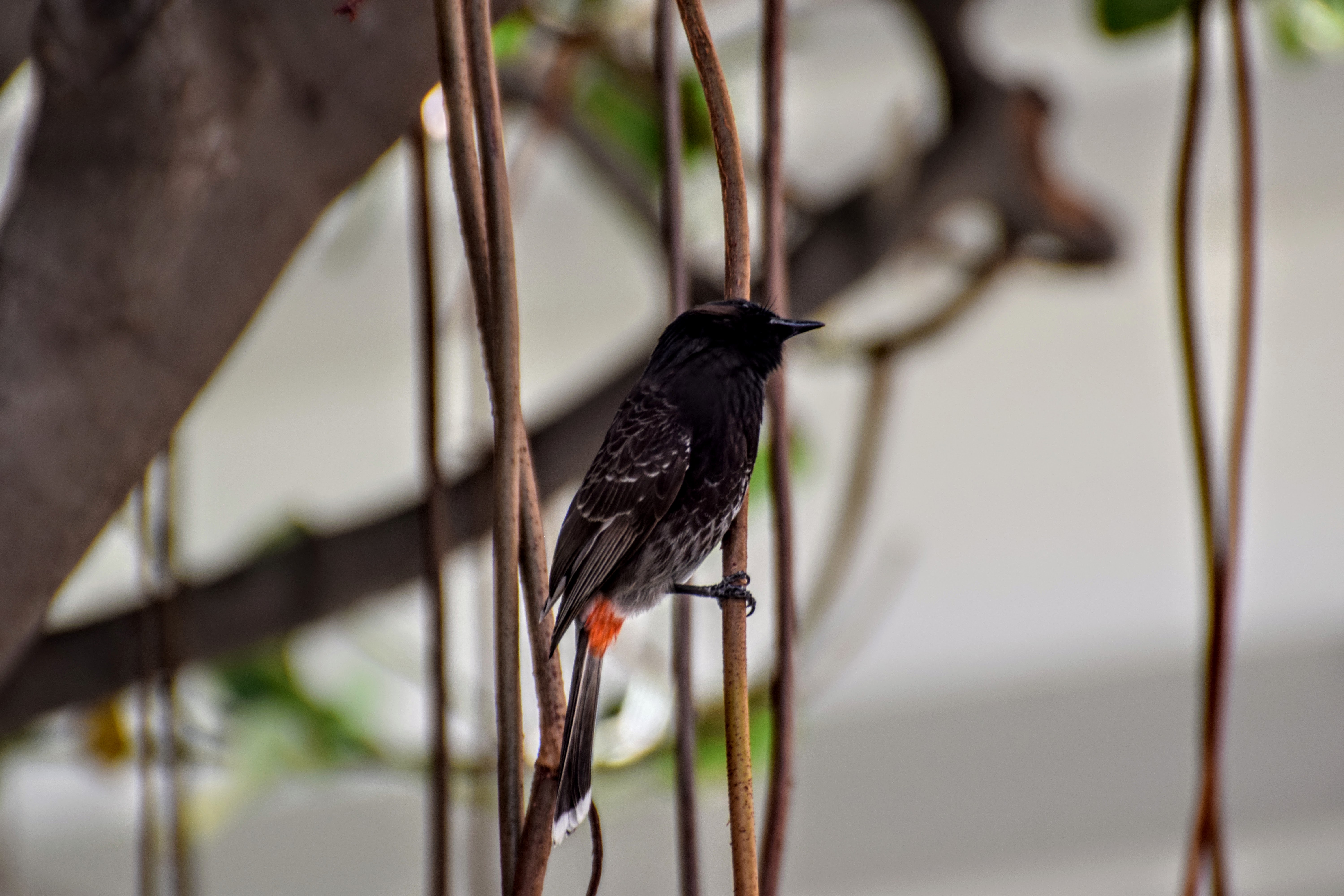
This is a Red-Vented Bulbul, another bird that follows my naming convention of color, body part, silly word. The other members of this family include birds called greenbuls, brownbuls, and leafloves. Seriously, who comes up with these things?
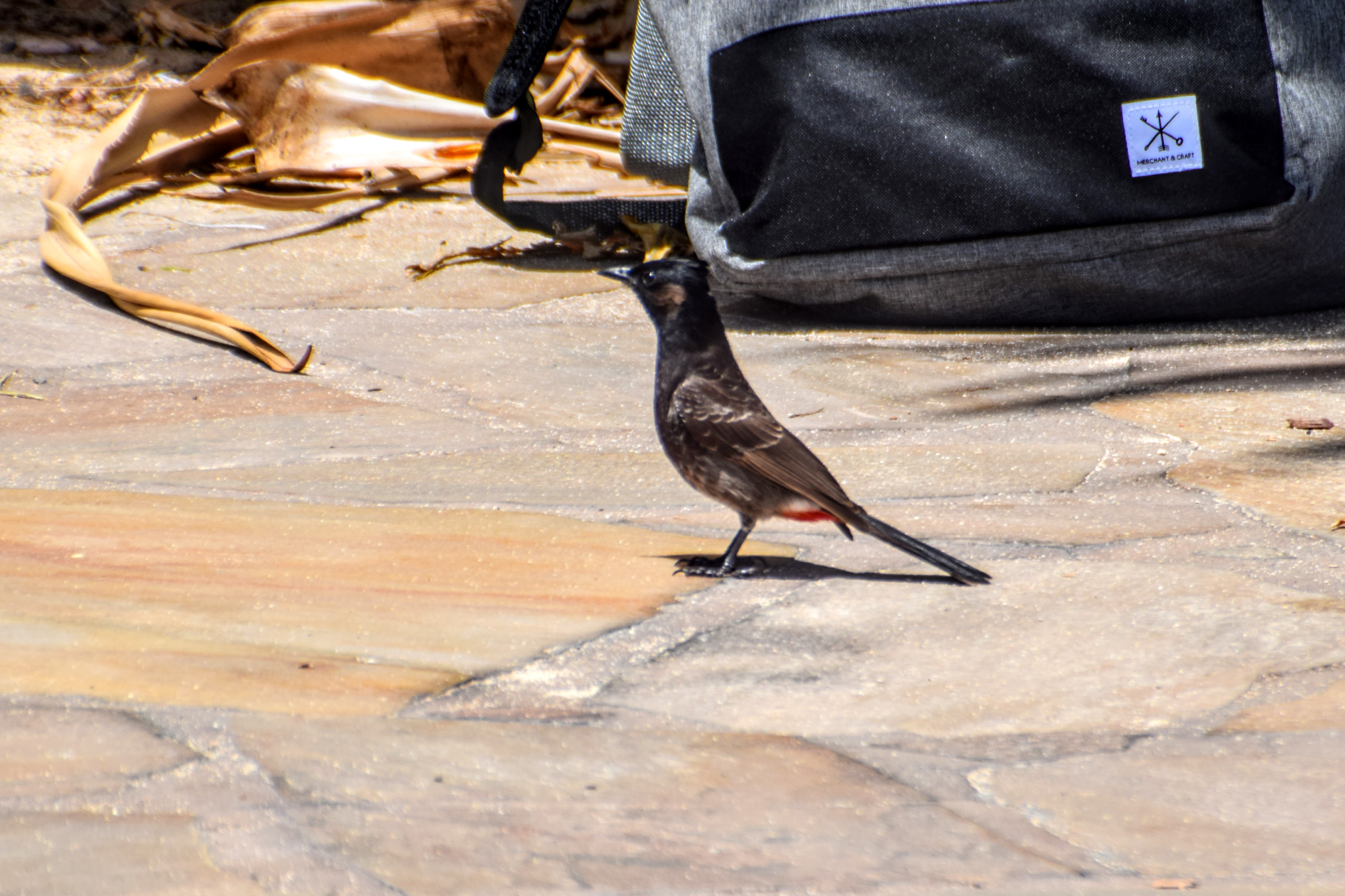
The Red-Vented Bulbul is considered one of the top 100 worst invasive species in the world. It’s native to Southeast Asia but has been introduced across Oceania.
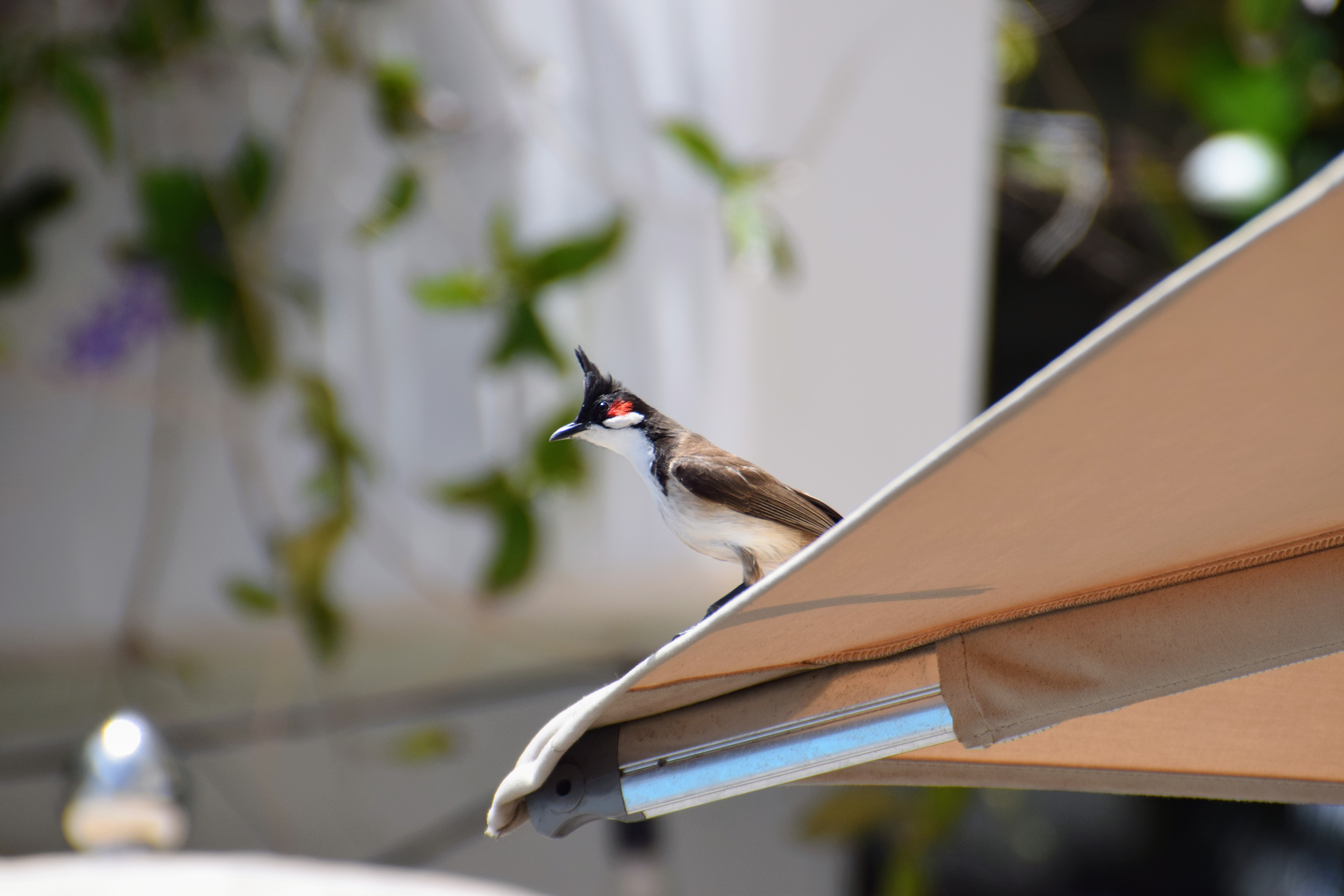
This is a Red-Whiskered Bulbul, a close relative of the Red-Vented that’s much less abundant. Bulbuls are in the superfamily Sylvioidea, along with the babblers and white-eyes.
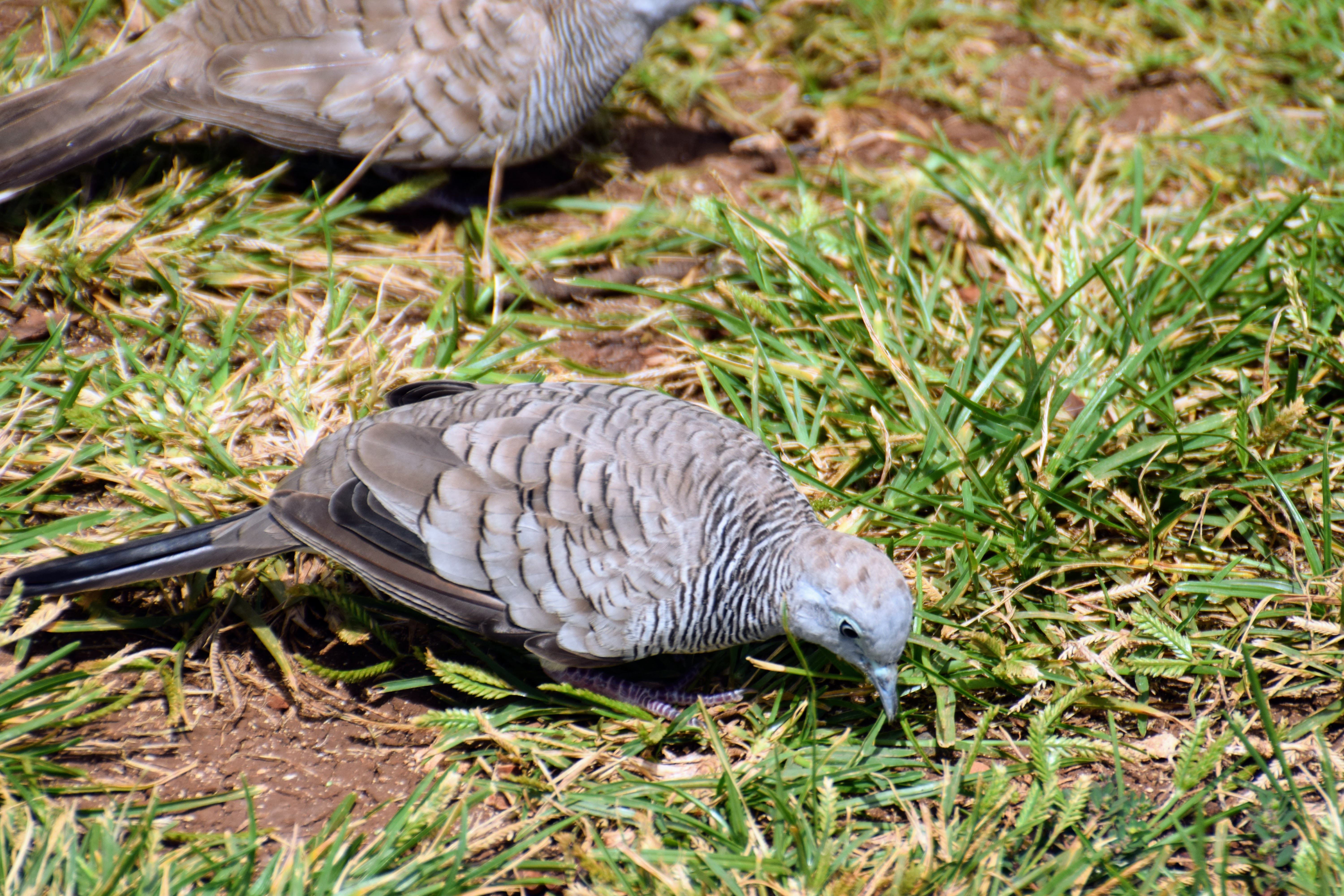
This is a Zebra Dove, a very small and cute dove that was playing the pigeon’s role at the resort. They were super abundant and not afraid of people.
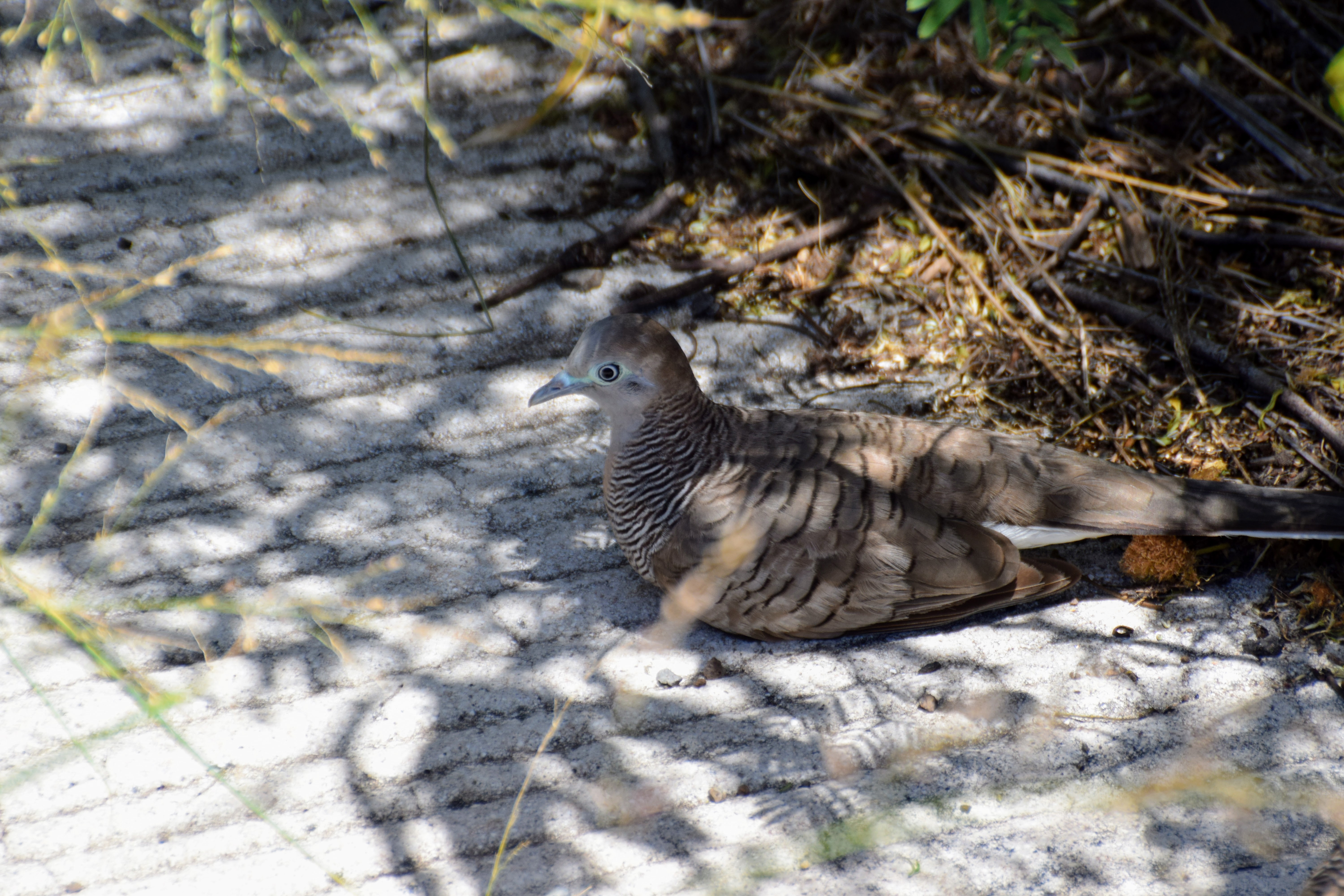
This one was resting in the shade on a hot day.

Here, you can see the size difference between the Zebra Dove and Rock Pigeons. The pigeons look like football players in comparison! For some reason, pigeons were much more common in Honolulu than on the west side of the island, and there were more pale-colored ones than in California.
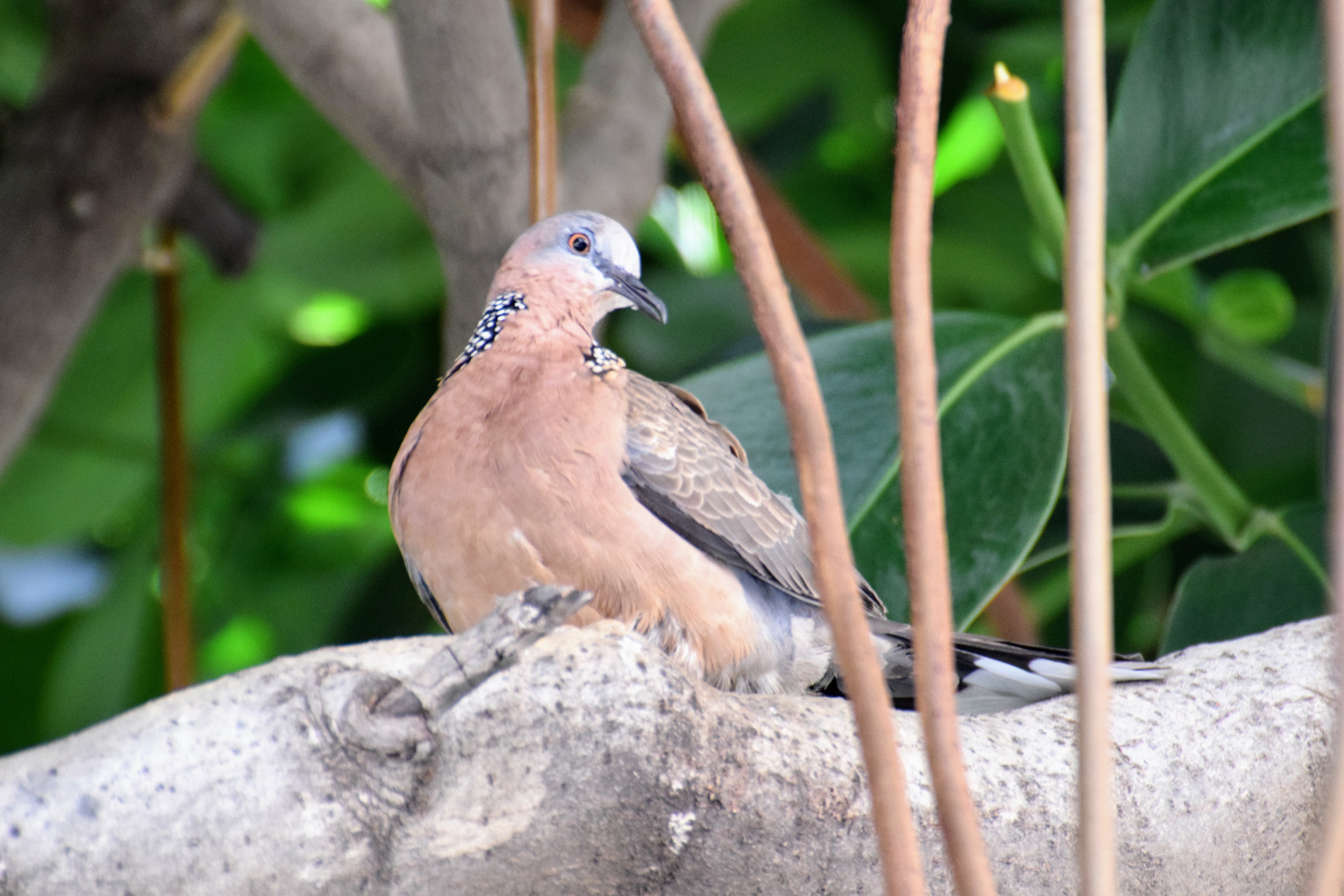
This is a Spotted Dove that we named Stumpy, because he was missing a foot. We often spotted him scrounging for scraps in the resort’s breakfast area, where he seemed to make a decent living. There was also a Zebra Dove missing a foot, which we named Small Stumpy, but I failed to get a picture of him.
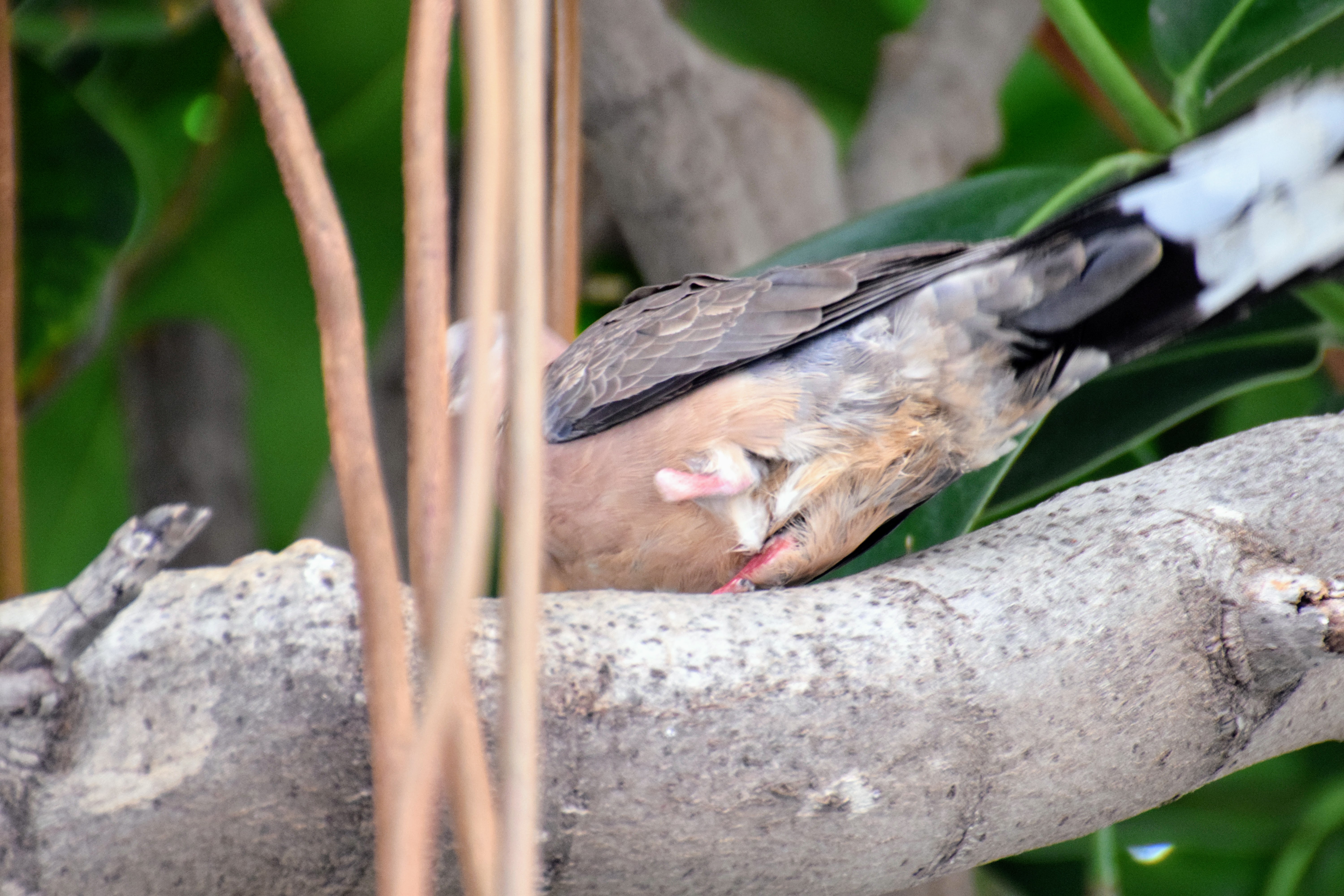
A close-up on Stumpy’s stump. The reason so many urban pigeons are missing toes is because they get human hair wrapped around their feet, cutting off blood flow, and they aren’t smart enough or dextrous enough to untangle themselves. :’(
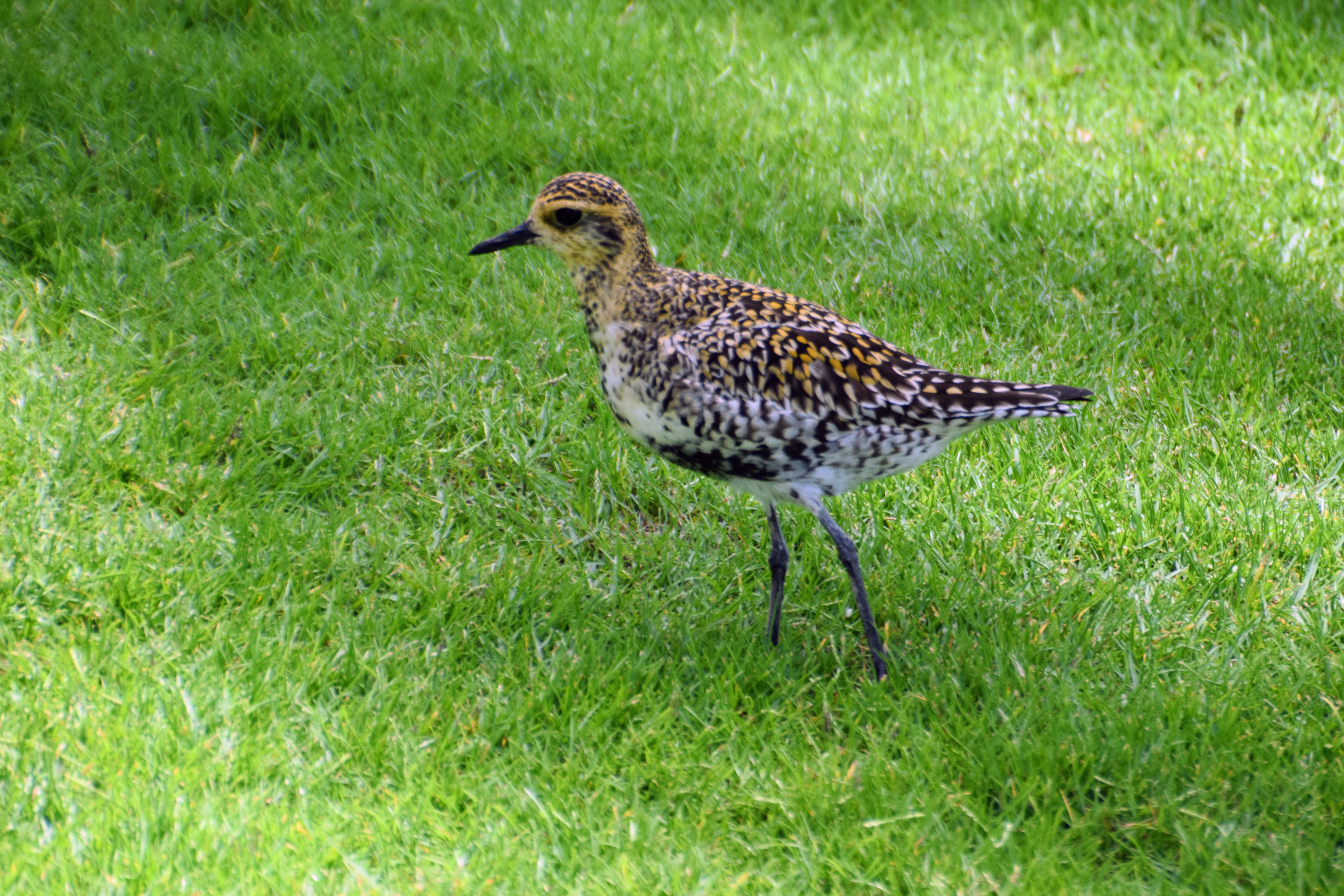
This is a Pacific Golden-Plover, a type of shorebird that migrates from Alaska and Siberia to the Pacific tropics and back every year. They were quite common around the resort, and mostly ignored other birds and stayed focused on finding worms under the lawn. This one is probably a juvenile, since it doesn’t have any black on its belly.
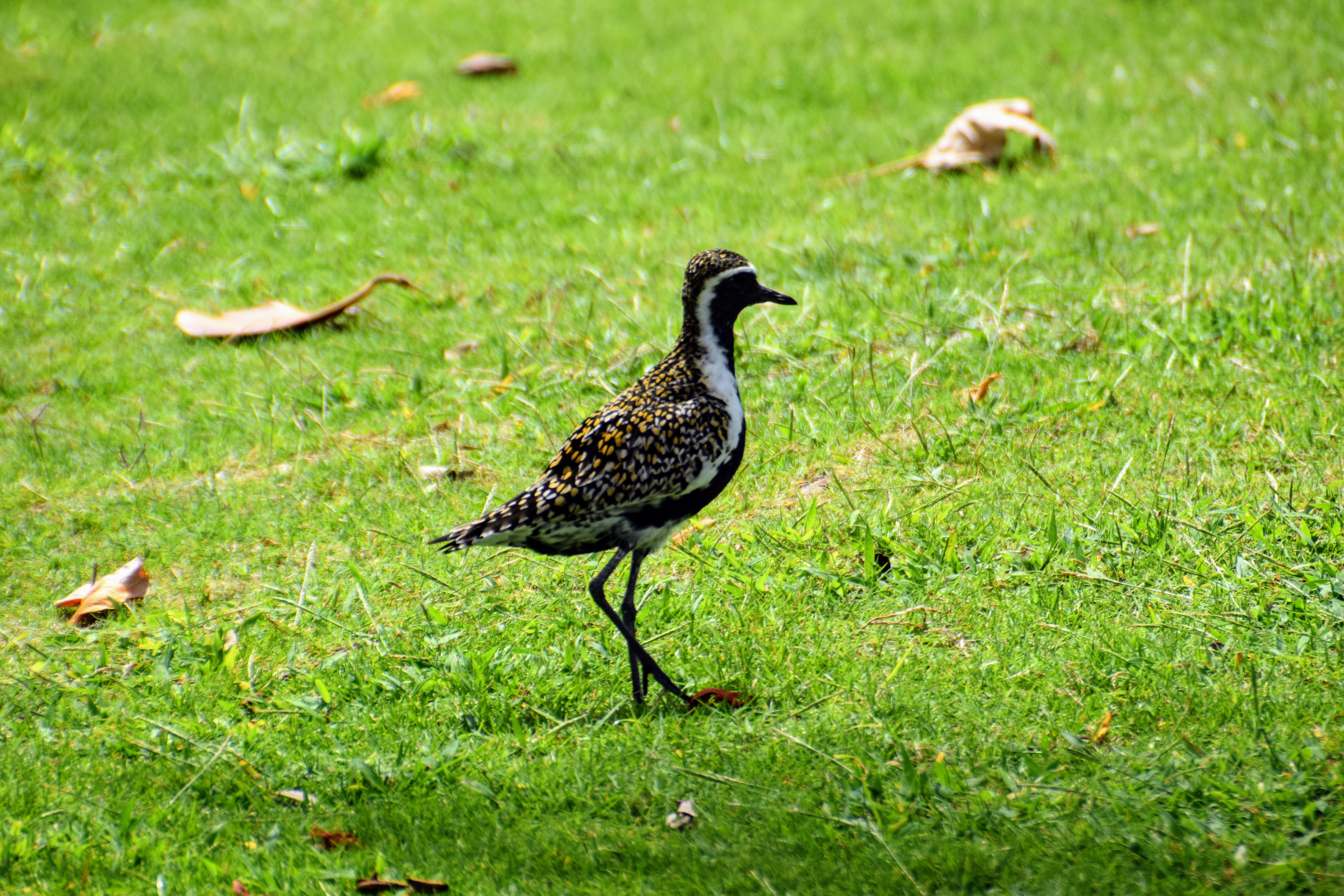
This is an adult male Pacific Golden-Plover. As my Hawai’ian uncle put it, he’s “put his tuxedo on” in preparation to migrate back to the Arctic.
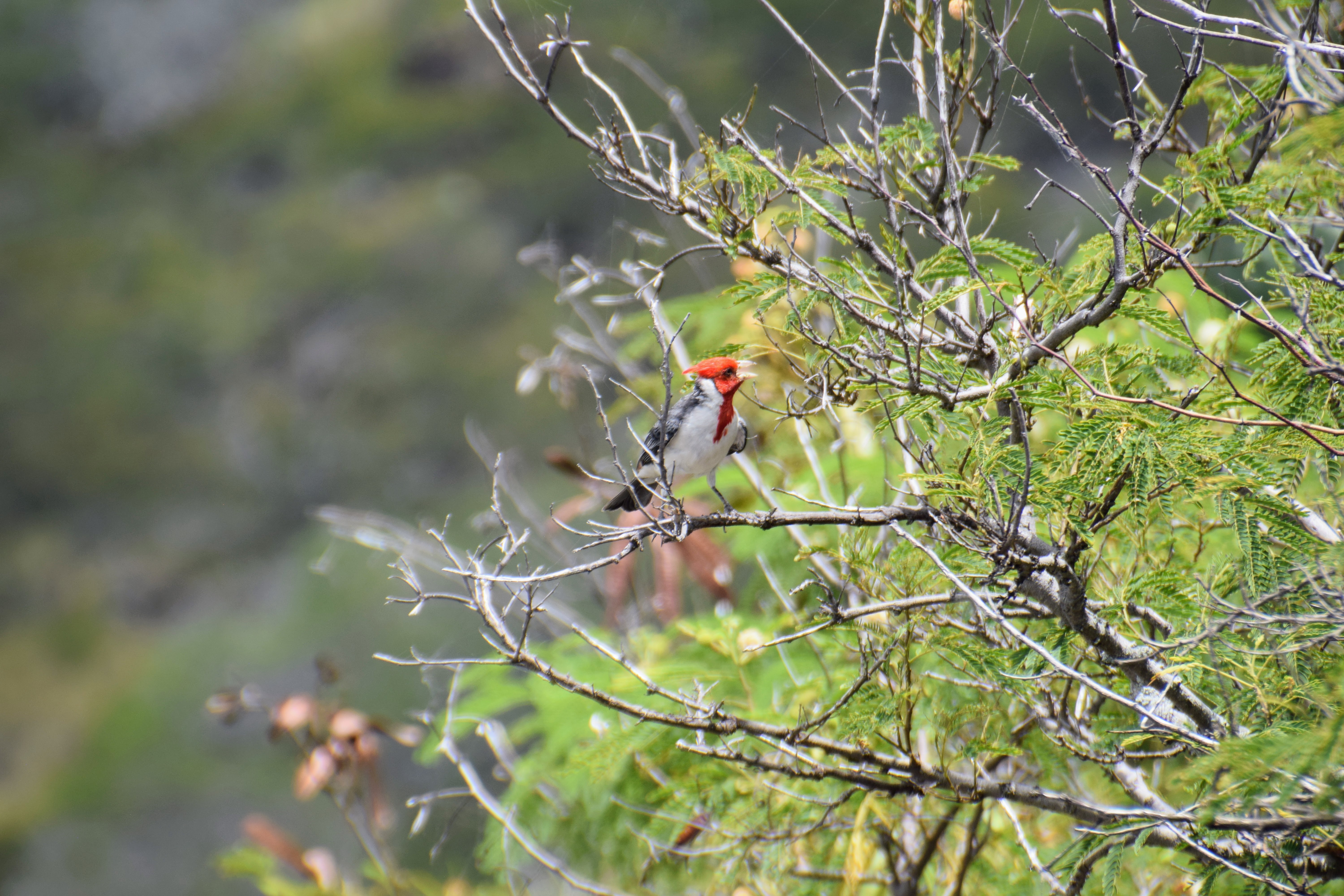
This is a Red-Crested Cardinal. I think it looks cooler than the all-red Northern Cardinal, but my husband thought it just looked like they didn’t finish painting it. Unlike the Northern Cardinal, male and female Red-Crested Cardinals look the same.
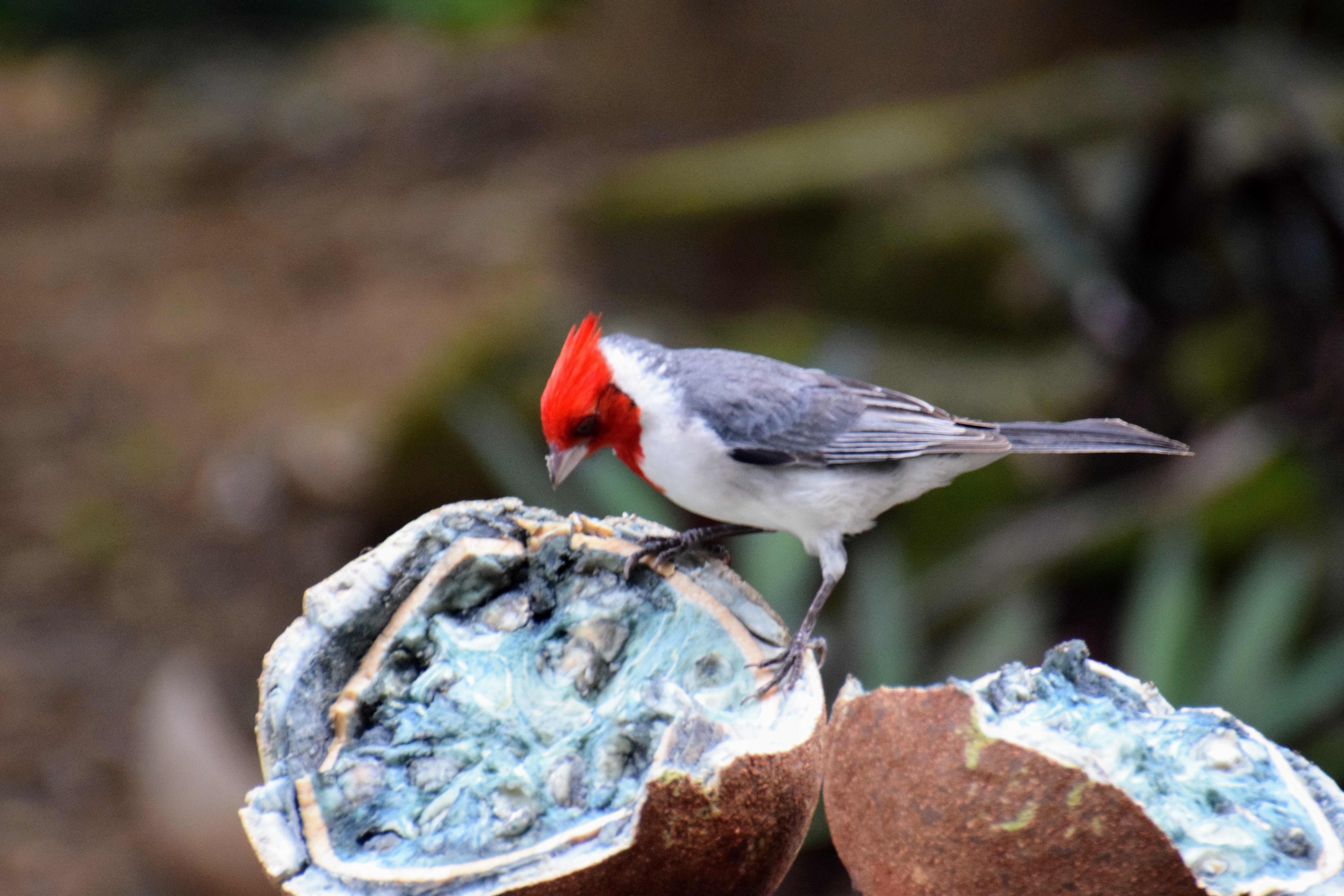
This one was inspecting a moldy-ass coconut. Despite the name and similar appearance, Red-Crested Cardinals are more closely related to a lot of non-red and non-crested tanagers than they are to Northern Cardinals. I wonder what’s so useful about the little triangular head crest? Jays, these two cardinals, cockatoos, waxwings, and others all evolved the same type of crest multiple times. In cockatoos at least, it’s very expressive and is useful in social communication.
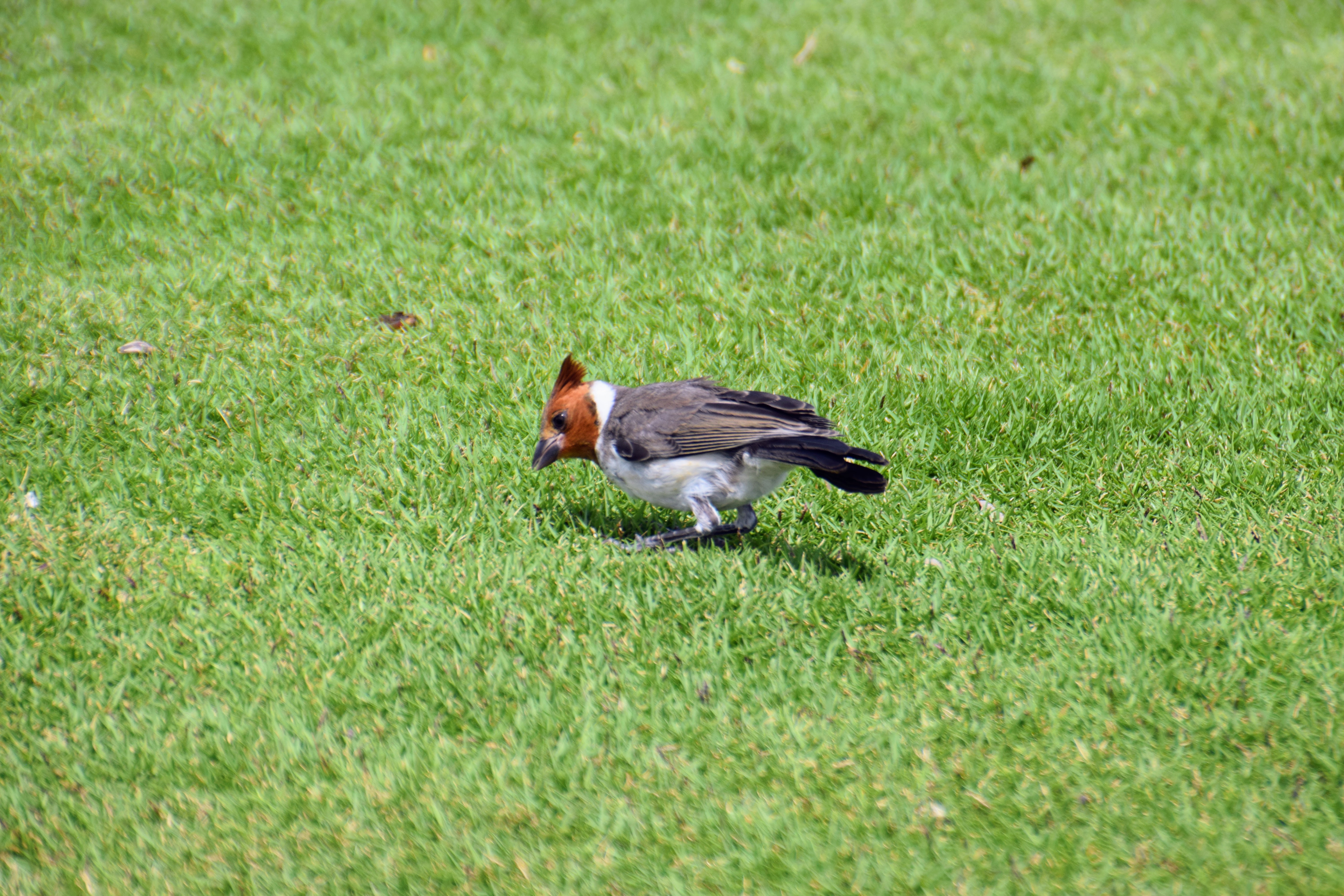
You can tell this is an immature Red-Crested Cardinal by the dullness of the red.
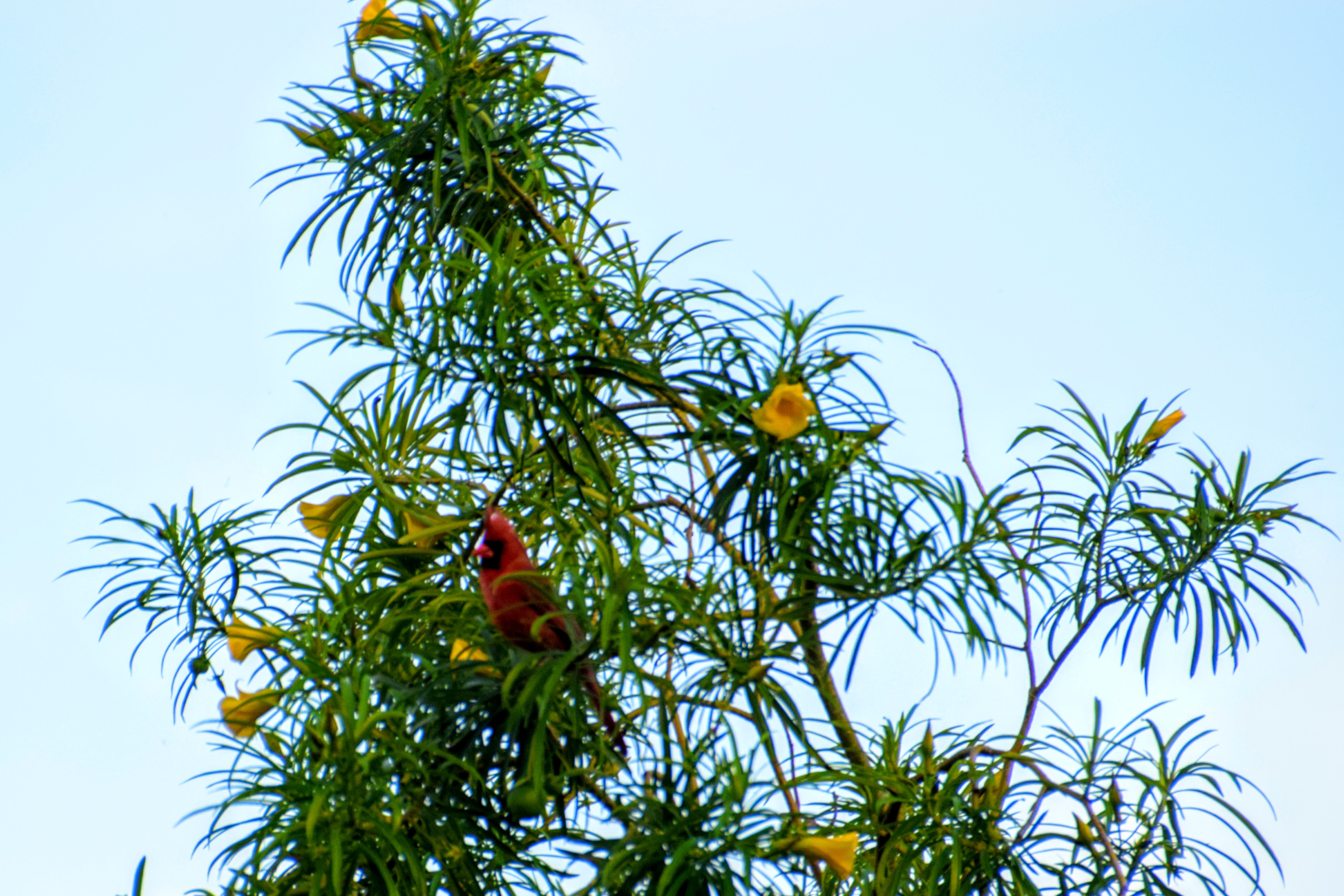
There were also all-red Northern Cardinals in Hawai’i, but they were a lot less common.
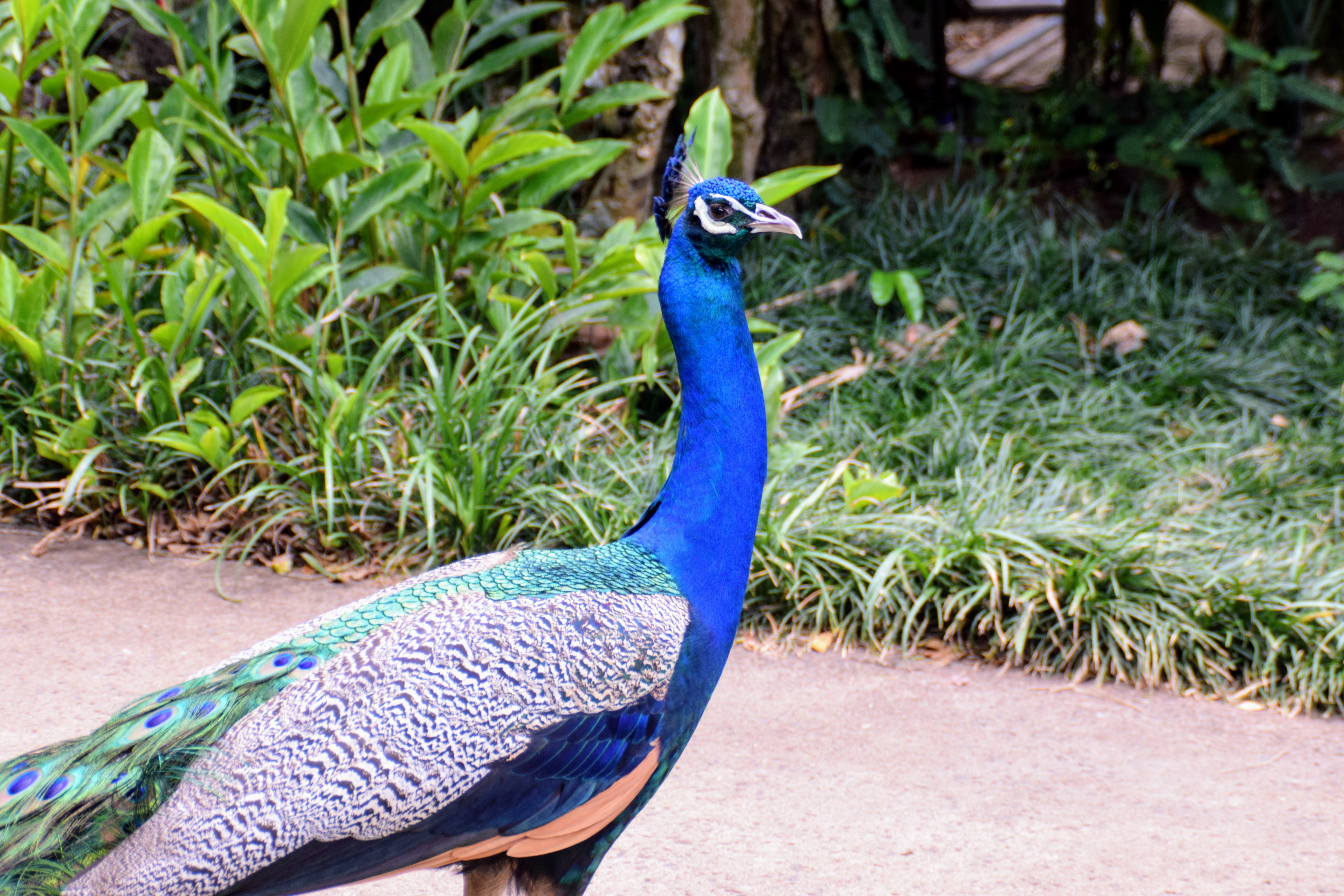
This male Indian Peacock was strutting in front of a crowd. Peacock calls sound kind of like a person pretending to be a bird.
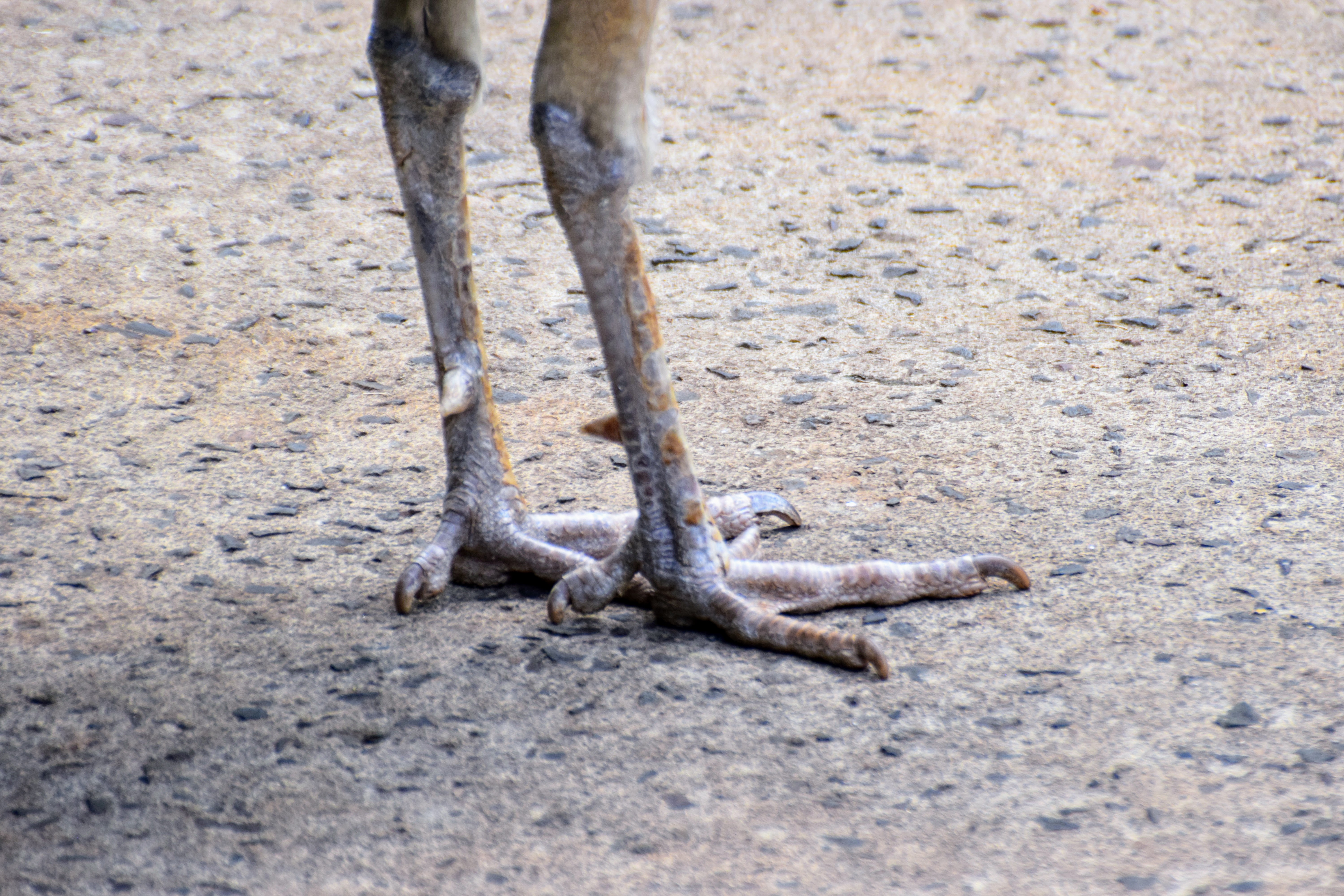
A close-up of the peacock’s feet. You can see the sharp spurs it uses for fighting.
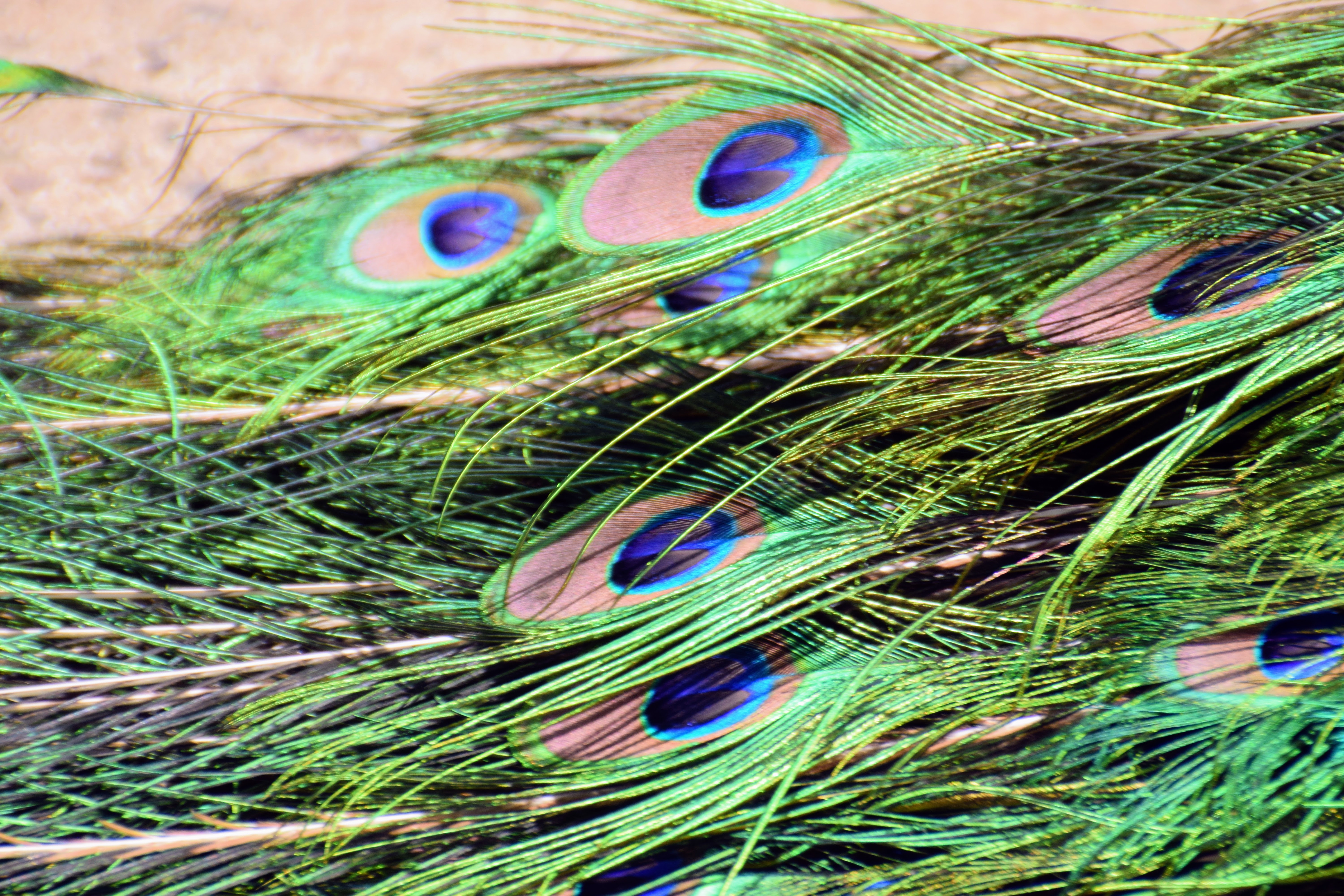
The peacock’s tail is not made of normal pinnate tail feathers, but highly elongated upper tail coverts. It does have normal-length tail feathers underneath all that!
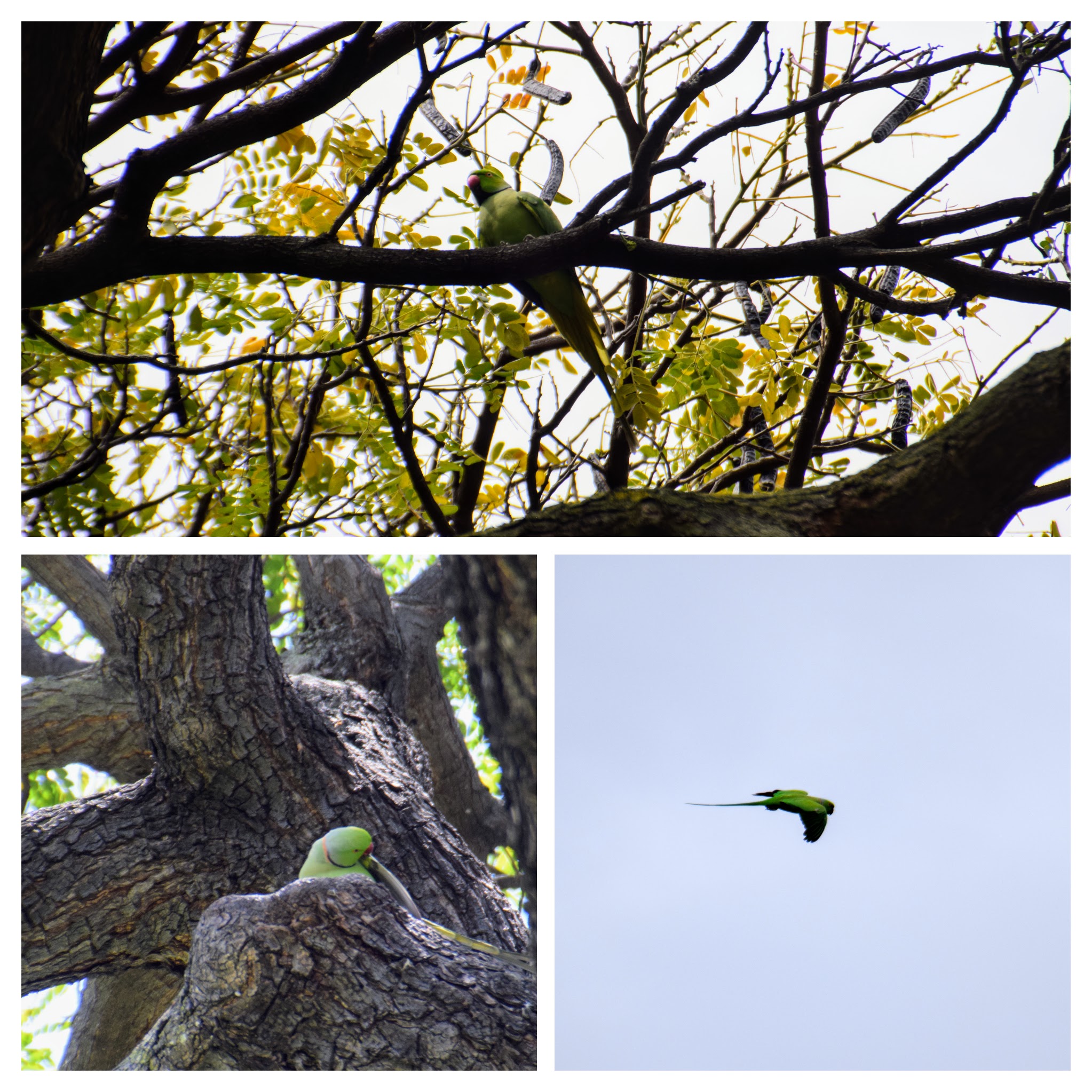
These are Rose-Ringed Parakeets (known in the pet trade as Indian Ringnecks), a parrot species that’s highly invasive across the world. The name is a bit misleading, as most of the ring is black and only a patch on the back of the neck is rose-colored.
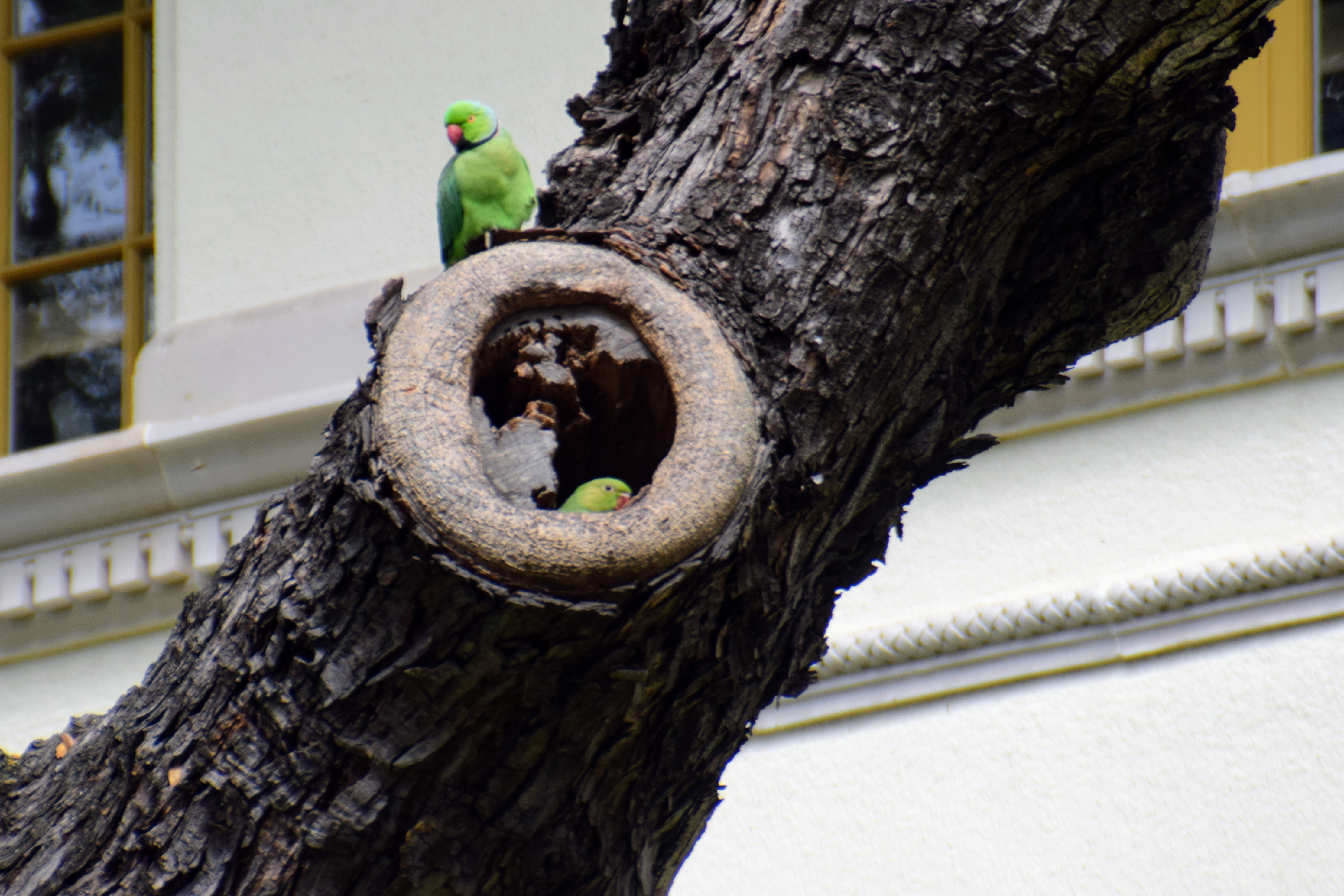
Rose-Ringed Parakeets nest in tree cavities like this. The one in the hole is the female, which doesn’t have the neck ring. In places where they’re invasive, they often outcompete other cavity nesters for these locations, especially bats.
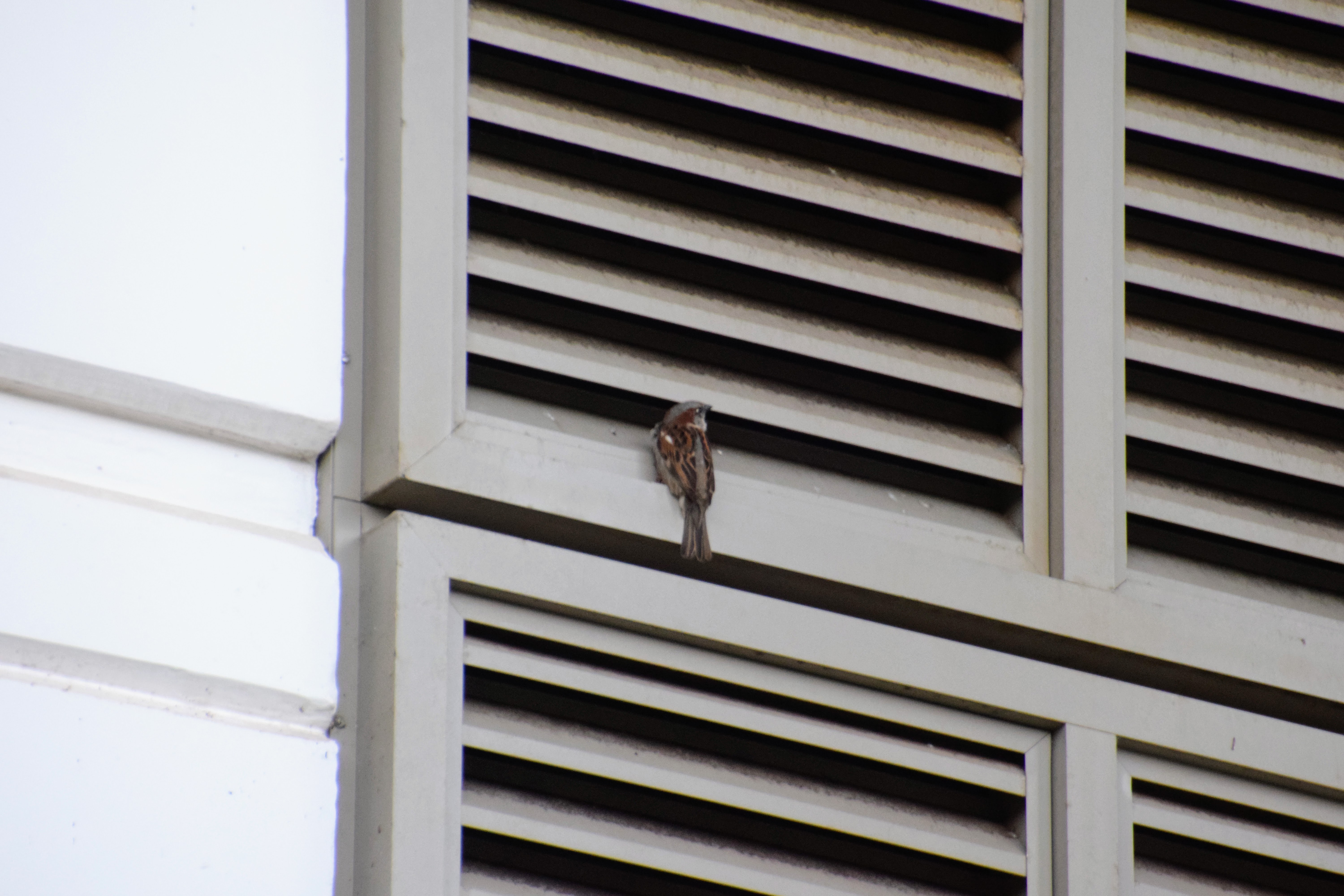
Like most places in the world, Hawai’i is home to abundant invasive House Sparrows. At the resort, they liked nesting in these air vents, whose slats they could barely fit through, but had a spacious internal area. When they were squeezing in and out, they looked like mice!
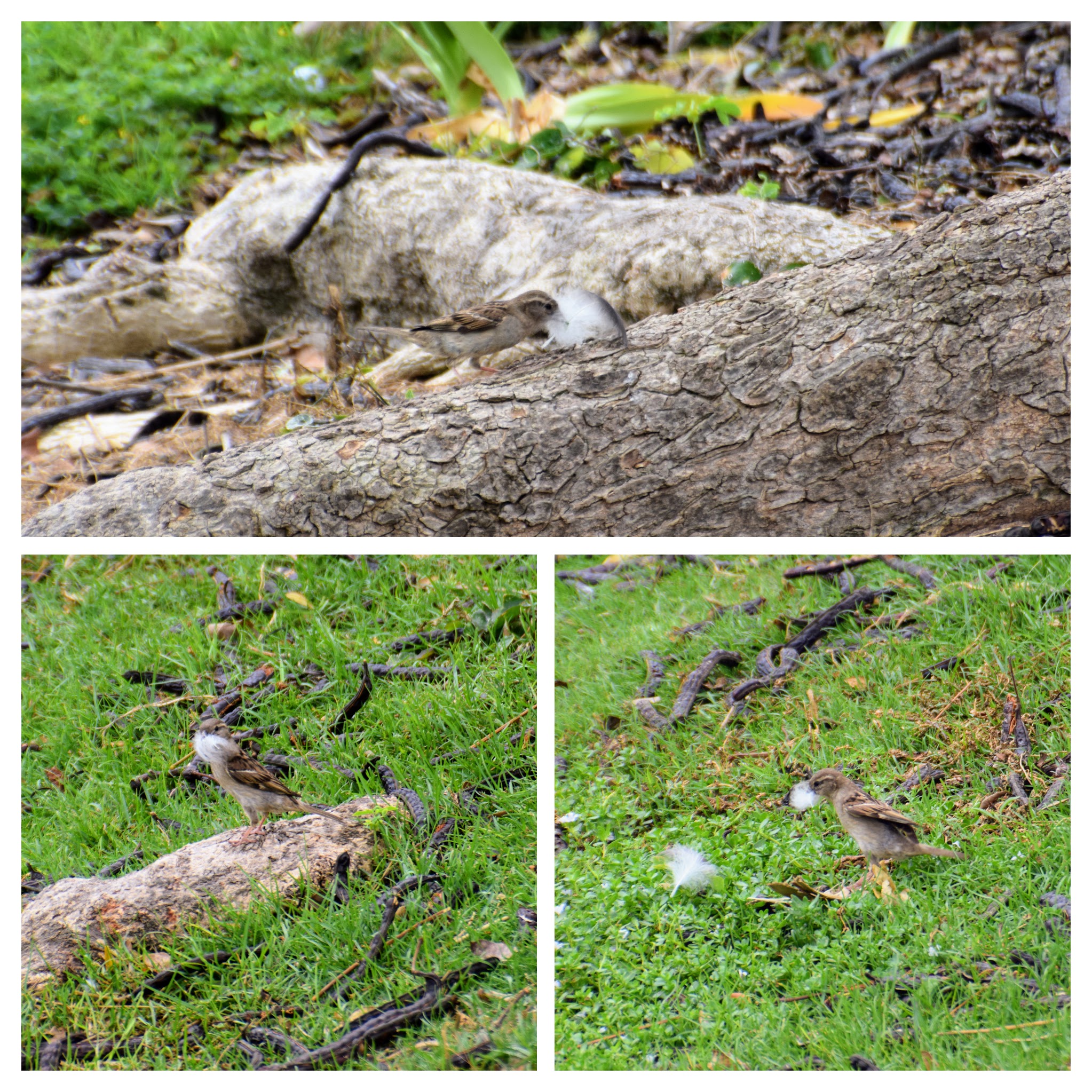
Here’s a female House Sparrow gathering up shed down feathers from Black Swans to make a nest.
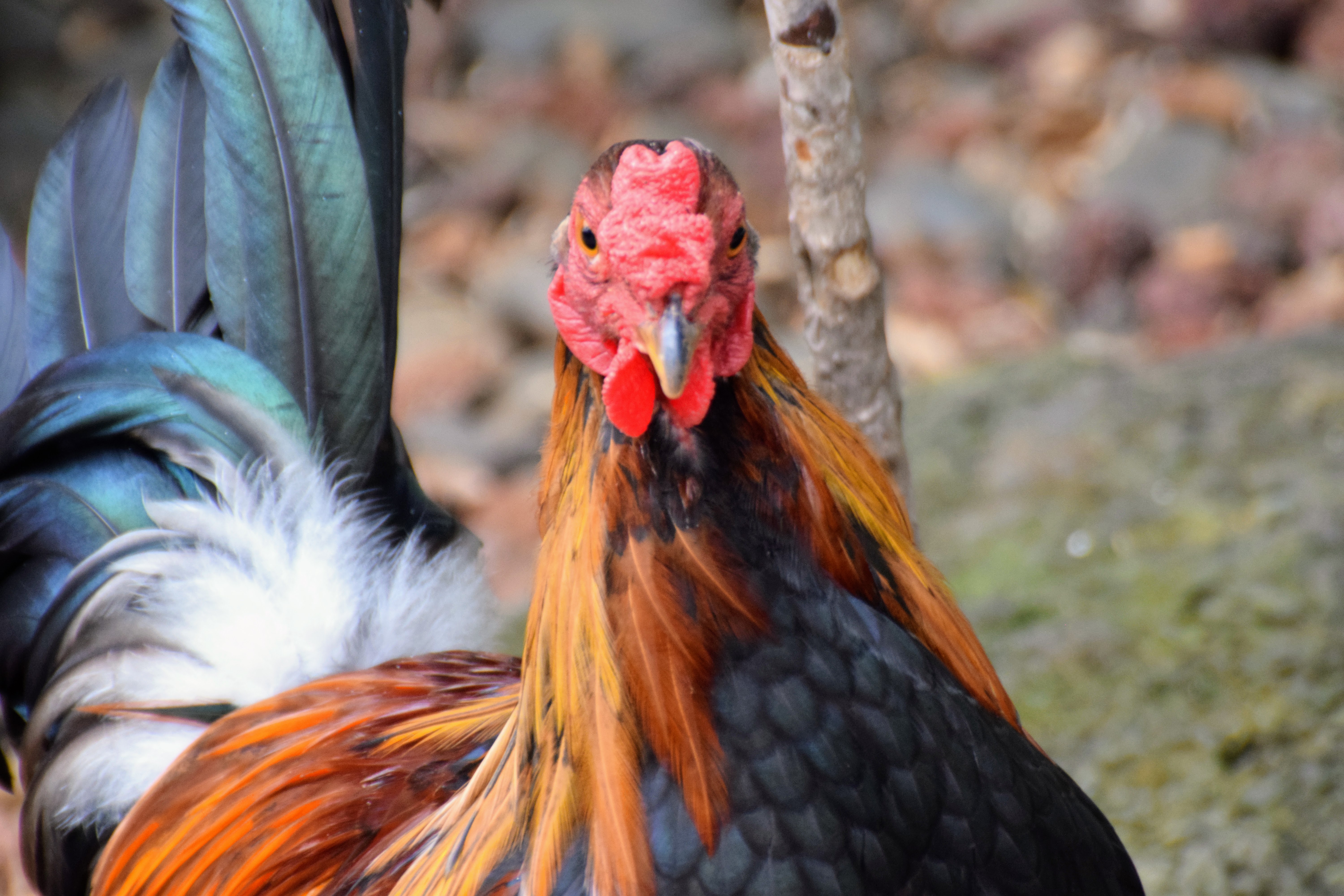
Another common neighborhood bird was the Red Junglefowl, or “original chicken”. These birds are native to Southeast Asia and specialize in making the most of cicada mast years by reproducing prolifically when food is plentiful. This trait made them perfect for domestication, in which food is always plentiful.
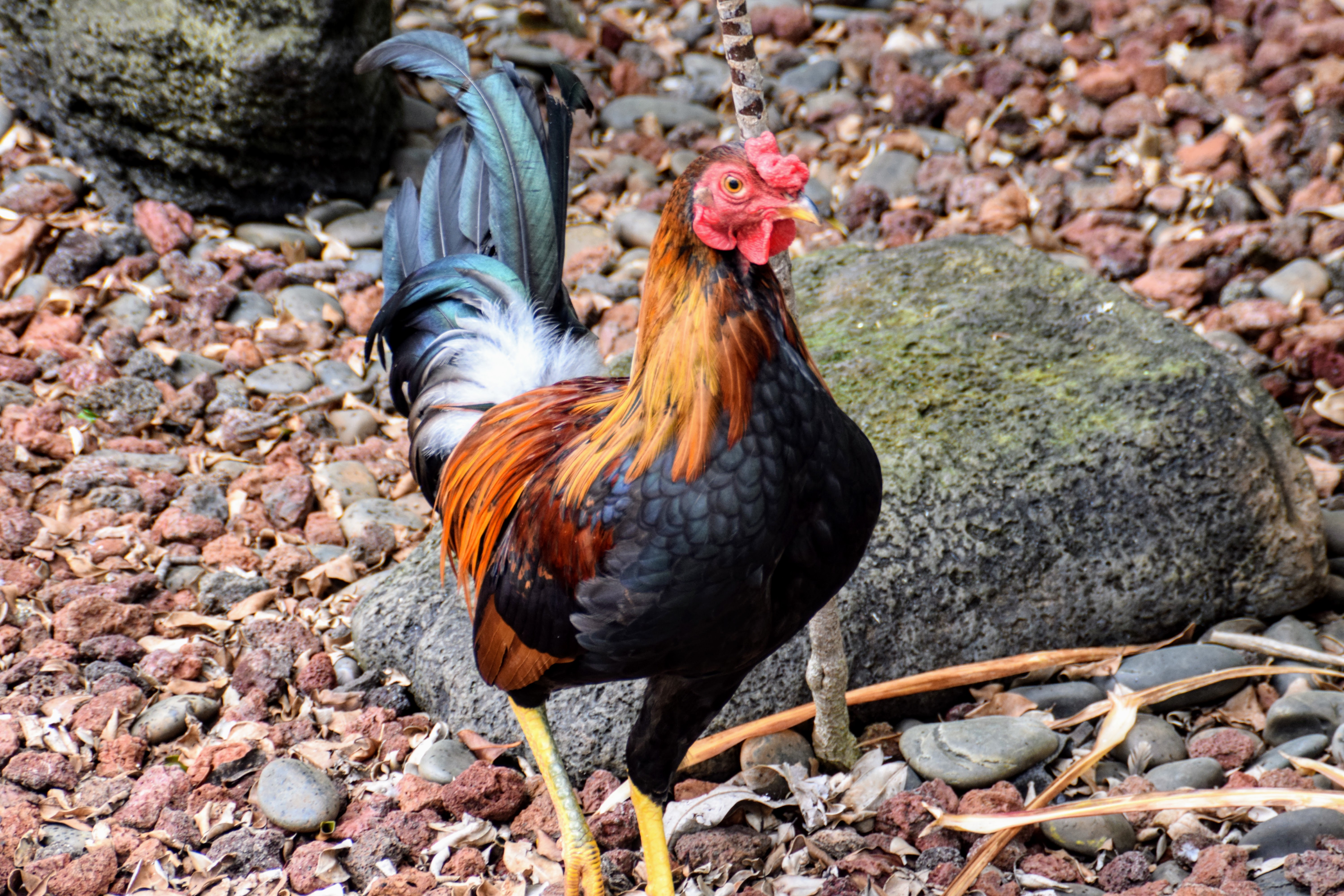
Most wild Red Junglefowl are probably hybridized with selectively bred chickens to some extent, but they are still noticeably slimmer than the ones you buy at the grocery store.
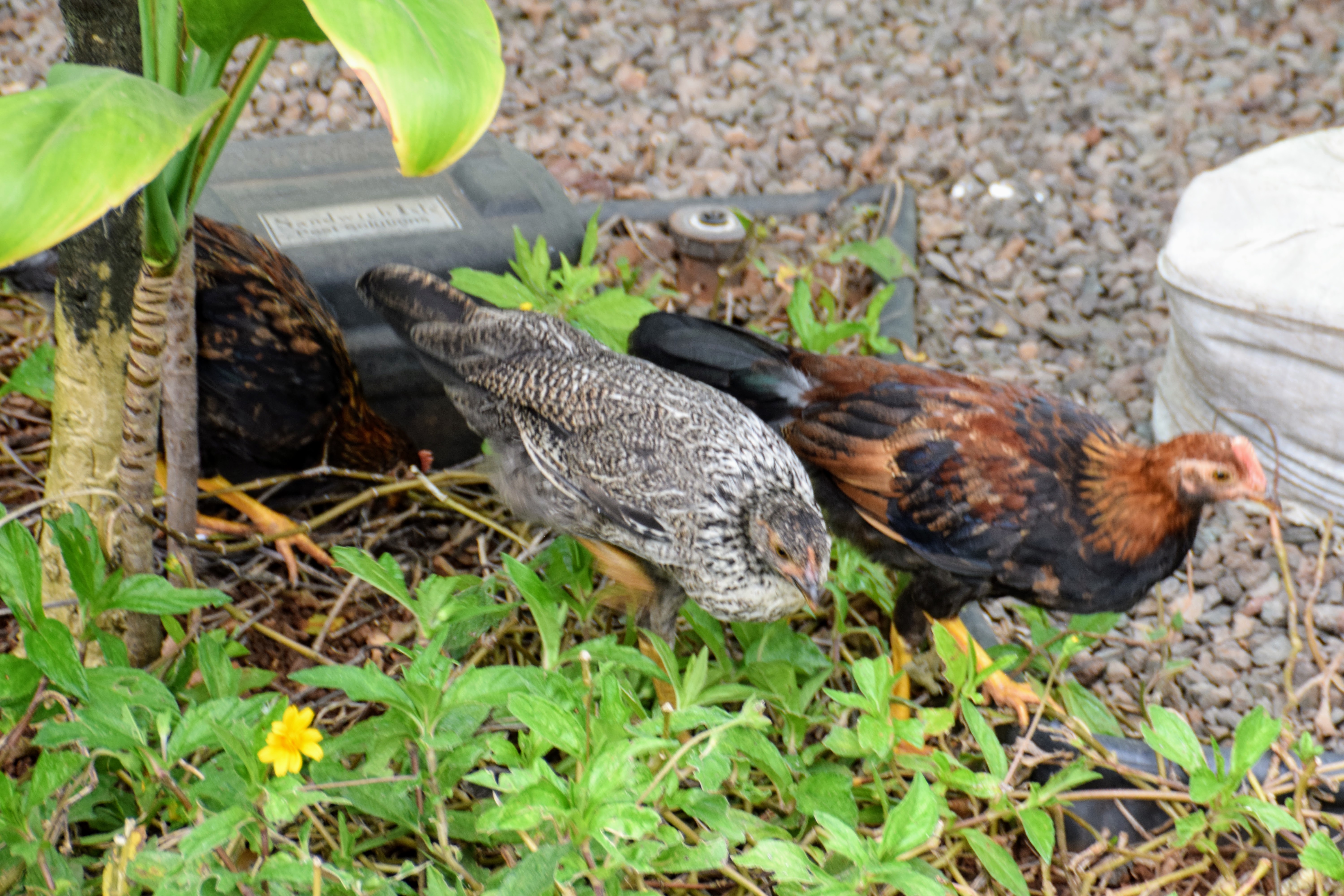
These small hens were foraging in a group.

This hen seemed to be the HBIC of the flock. She was much larger than the other hens and was watching over them while they foraged. The rooster was further away, not paying attention. I’m not sure why this hen was larger and had a rooster-like erect tail. Maybe the other hens are her children?
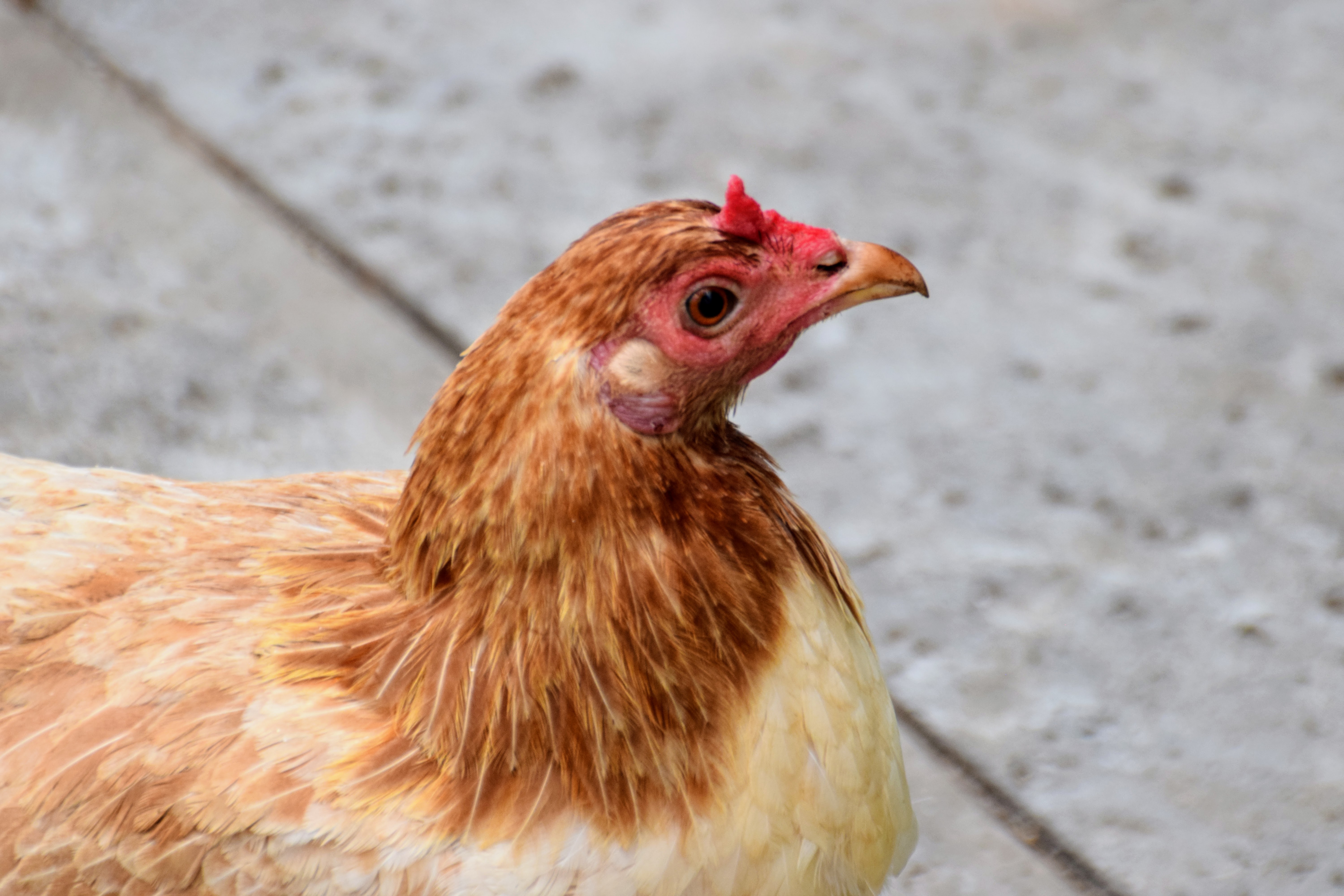
I thought she was quite handsome.
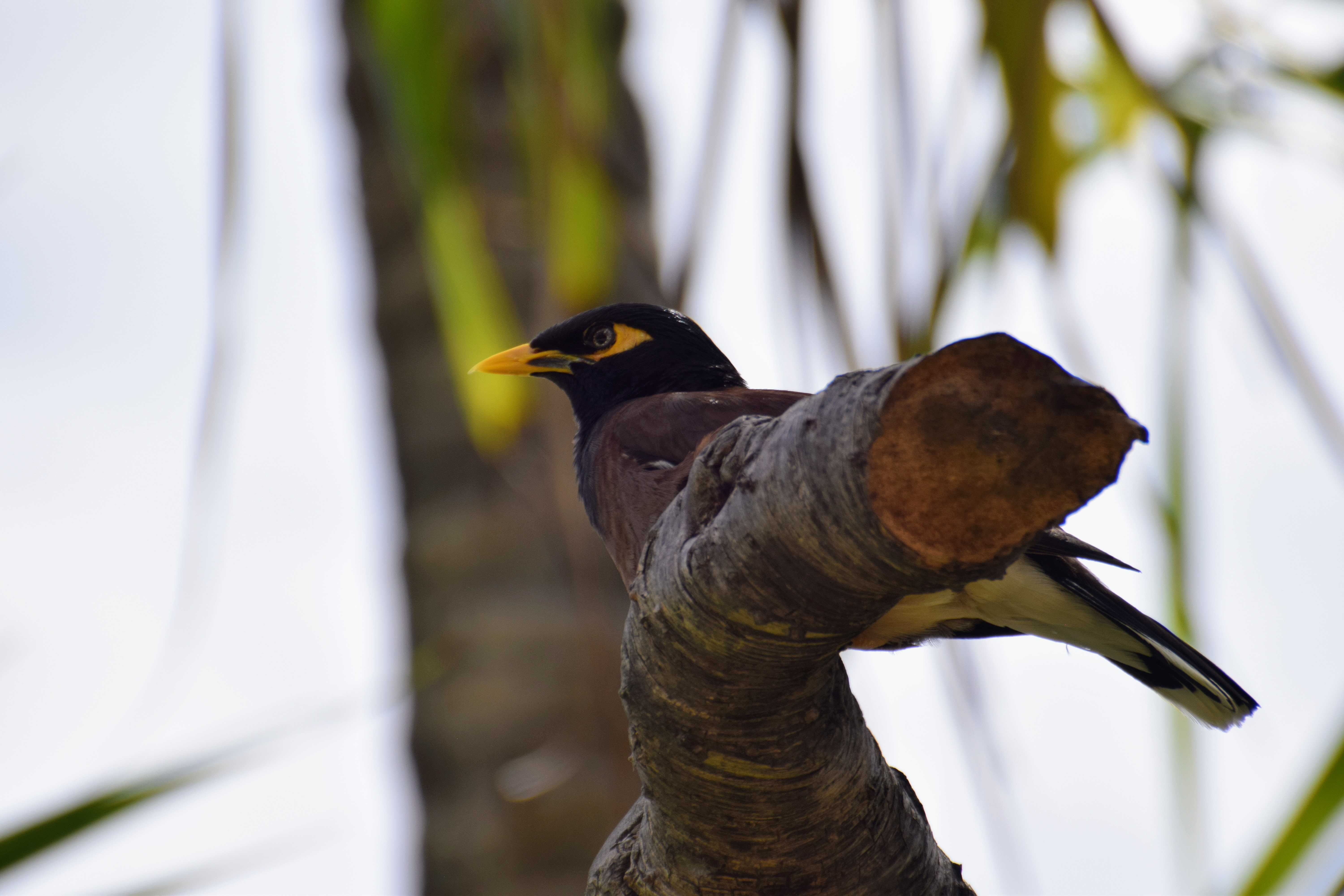
Filling the role of intelligent generalist scavenger bird was the Common Myna, an invasive species native to South and Southeast Asia. These guys were everywhere, stealing French fries, mobbing mongooses, and chattering at each other.
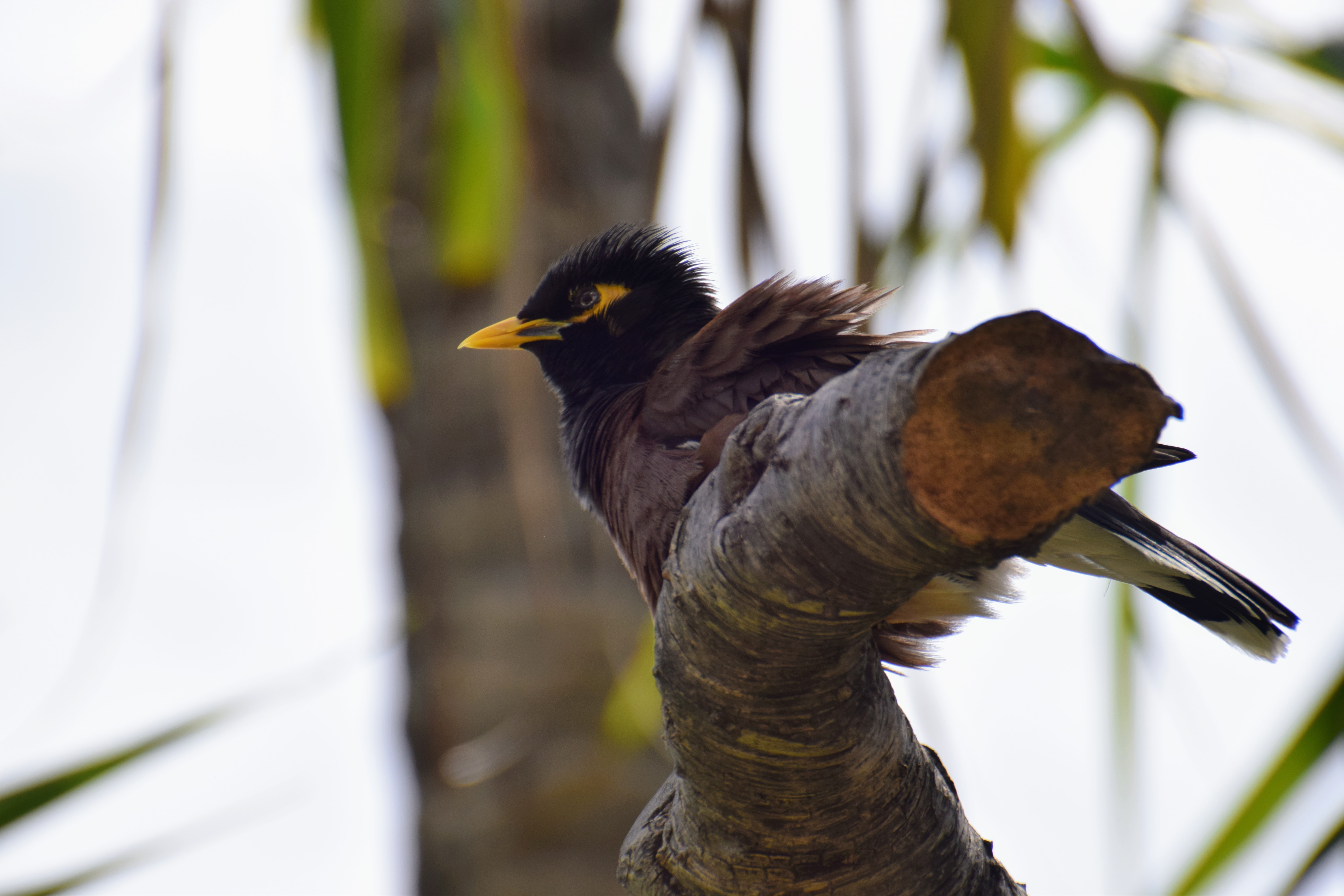
Ooh, windy.
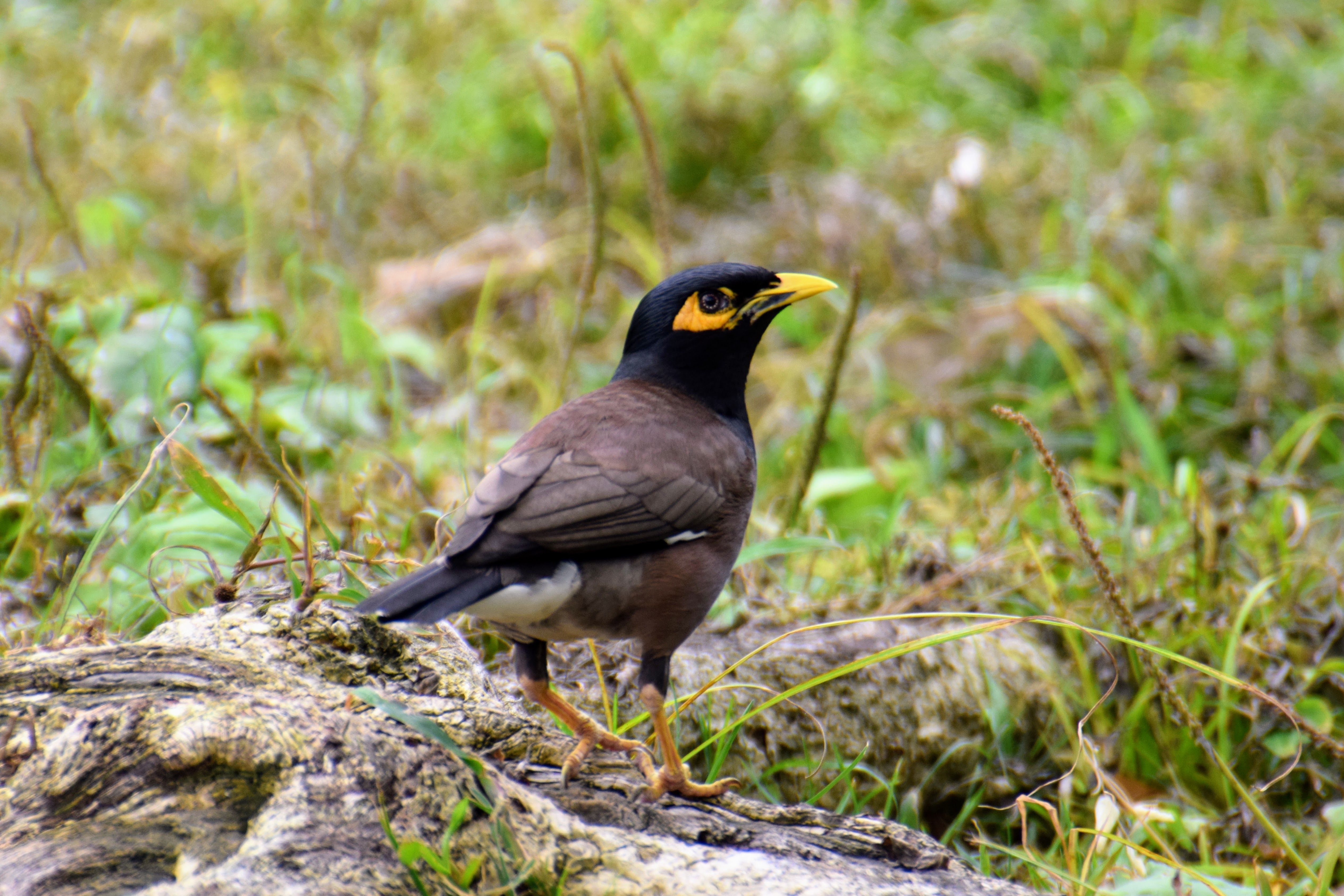
I think their black and white striped irises are stunning. Like little jewels.
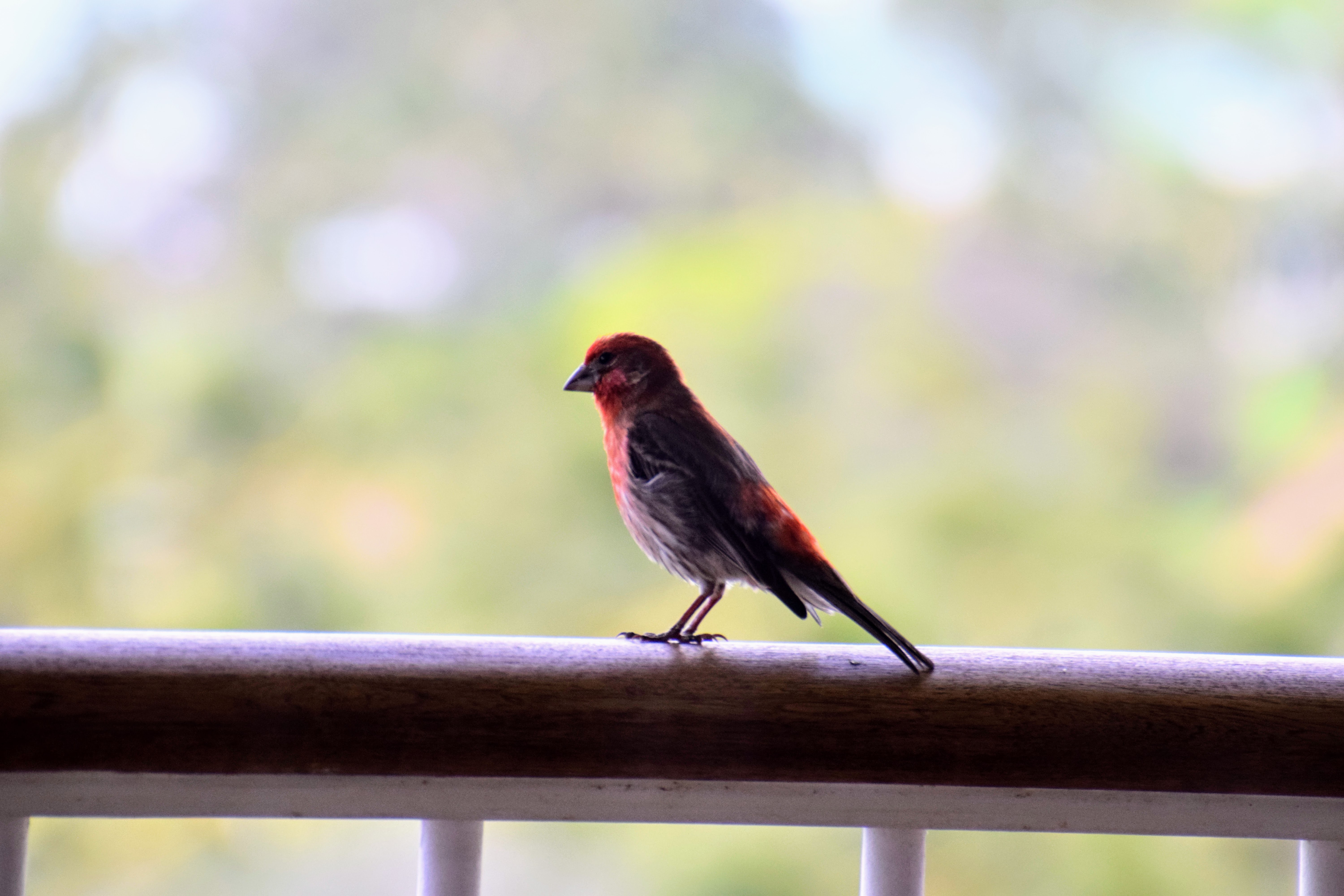
We have these in California as well: House Finches. I just thought this one was very pretty. These guys visited us on our hotel room balcony and ate cockroaches. (Even fancy hotels in the tropics have a goodly number of cockroaches!)

These are a rare type of bird known as Hawai’ian Window Washers. They nest on sheer vertical walls, and no sightings of female Window Washers have ever been recorded.

Look how high up they are! Do you think they climb mountains in their free time, or is that too much of a Busman’s Holiday?
Seabirds
We went out to sea a little ways on a powerboat to snorkel, and were super lucky to come across what the skipper called a “bird pile”. Also known as a bait ball, it was an area where a school of skipjack tuna were jumping out of the water to avoid some unseen marine predators below, and the birds were providing predation pressure from above. Brown Boobies were diving into the water, terns and noddies were snatching fish from the air, and we even saw a Great Frigatebird trying to get a piece of the action. Here are the seabirds we saw in descending order of size.
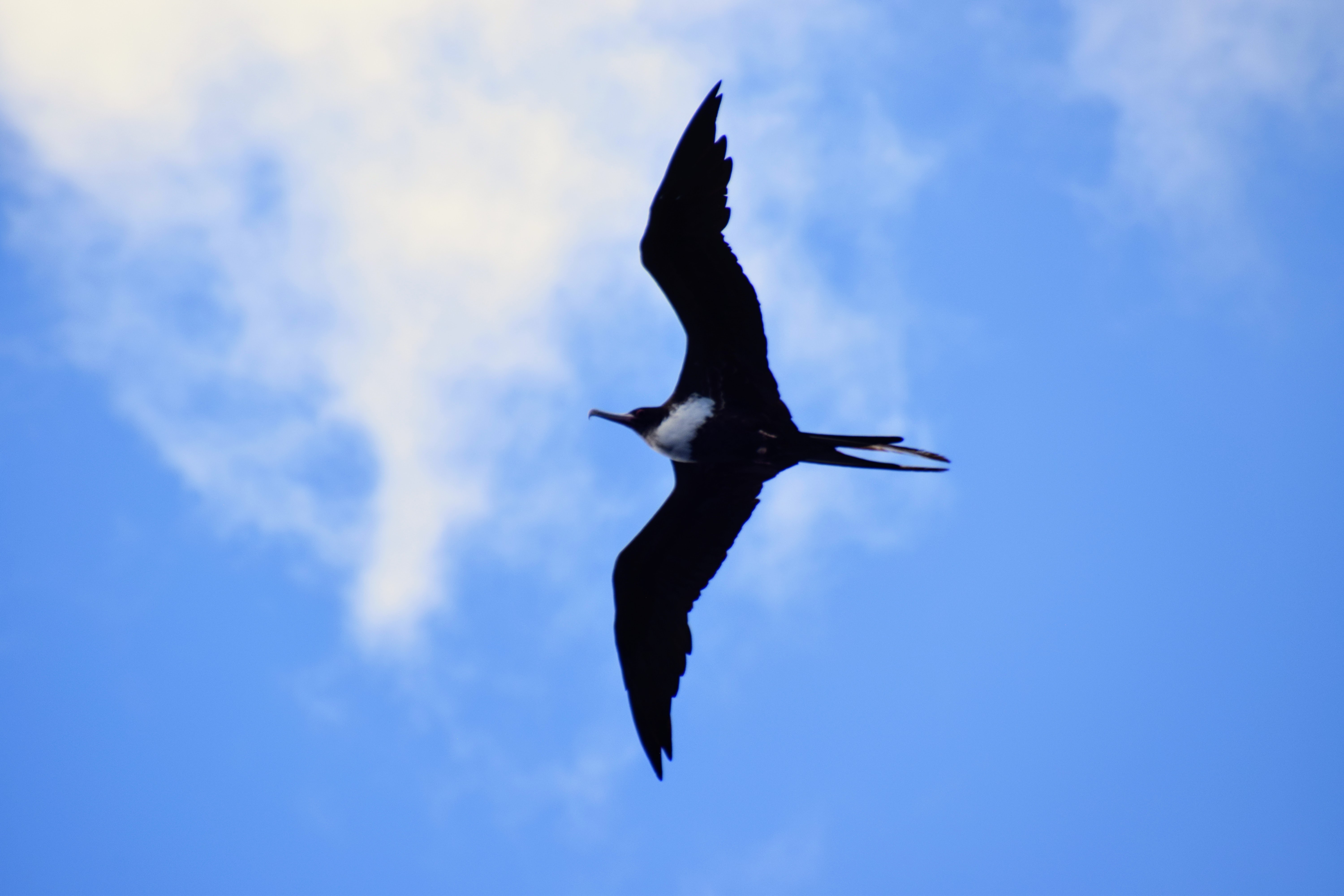
The Great Frigatebird is a huge seabird with airplane-like wings, related to boobies. It’s so huge and specialized for gliding long distances that it can’t easily launch off of the water, so it avoids water landings. This one is a female, as you can tell from the white throat patch. When courting, male frigatebirds inflate a huge red balloon-like throat sac and make booming noises, but when not courting the sac isn’t visible. Where does it hide?
In the Hawai’ian language, the Great Frigatebird is known as ‘iwa, meaning “thief” for its habit of bullying smaller seabirds into giving up their prey. Fishermen consider it good luck, as it’s usually seen in areas with abundant fish.
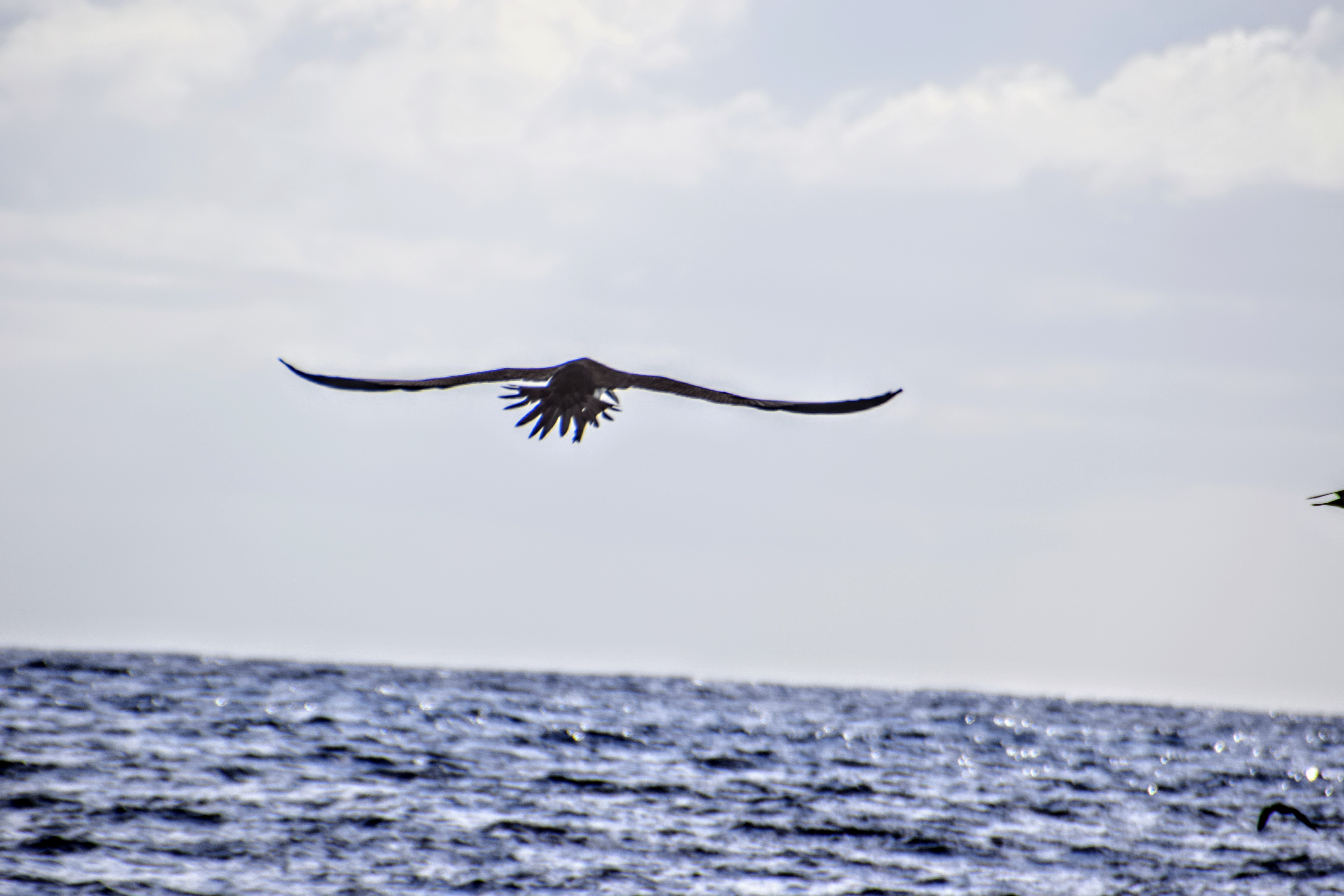
The welterweight in the “bird pile” was the Brown Booby. Unlike the solitary Great Frigatebird, there were several Brown Boobies in the flock. They were the ones diving head-first into the water; if you’ve read my bird book, the facts listed about the Northern Gannet mostly apply to boobies as well. It’s a shame that boobies have such a silly name and are known mostly for the awkward blue-footed courting dance. They’re actually very cool!
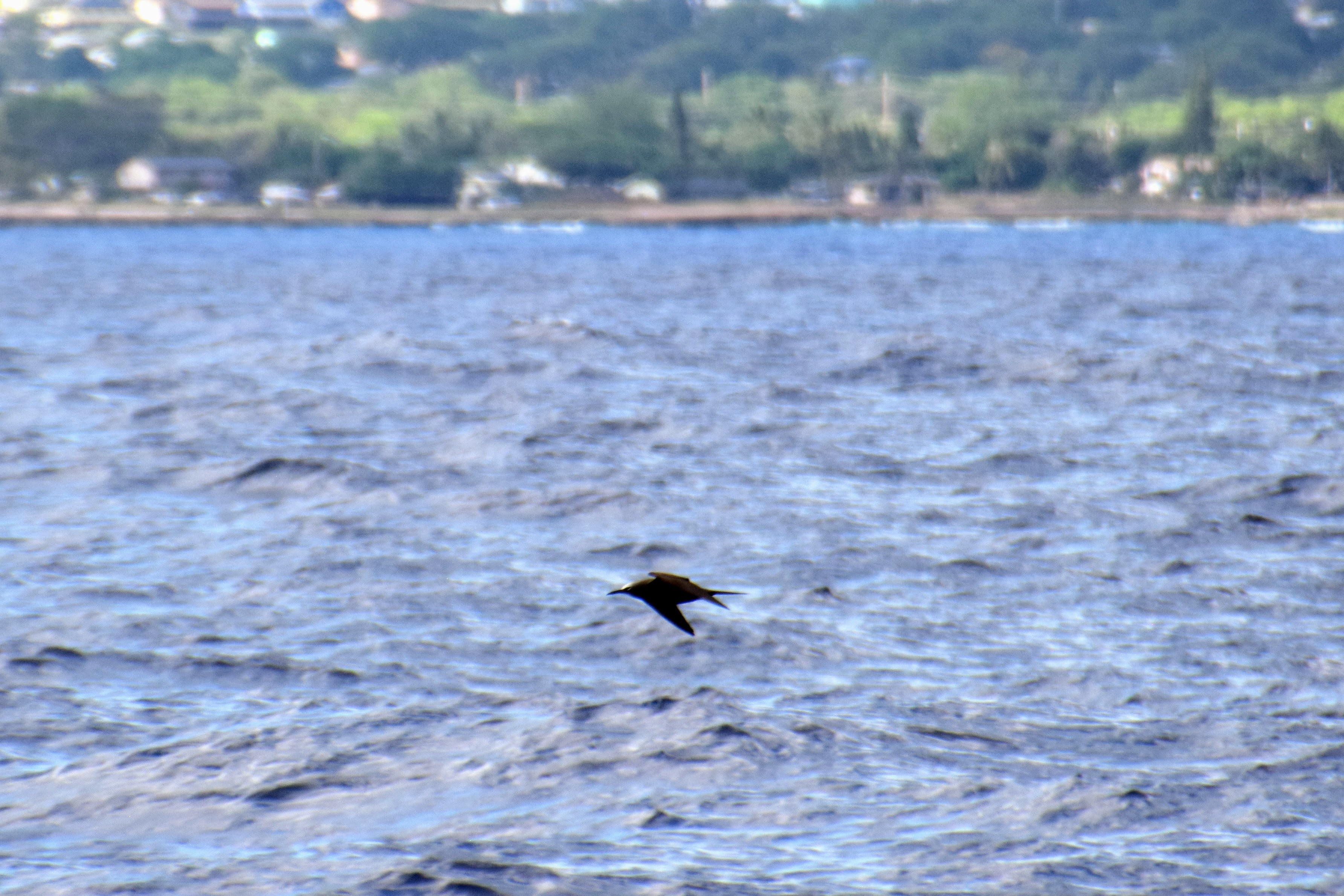
The lightweight of the “bird pile” was the Brown Noddy. While boobies and frigatebirds are part of the family Aequornithes, or waterbirds, which also includes herons, penguins, pelicans, albatrosses, and others, noddies and terns are part of the family Charadriiformes, or shorebirds, which also includes sandpipers, gulls, and auks (which look and act a lot like penguins). To me, noddies look like gulls that had some plastic surgery.
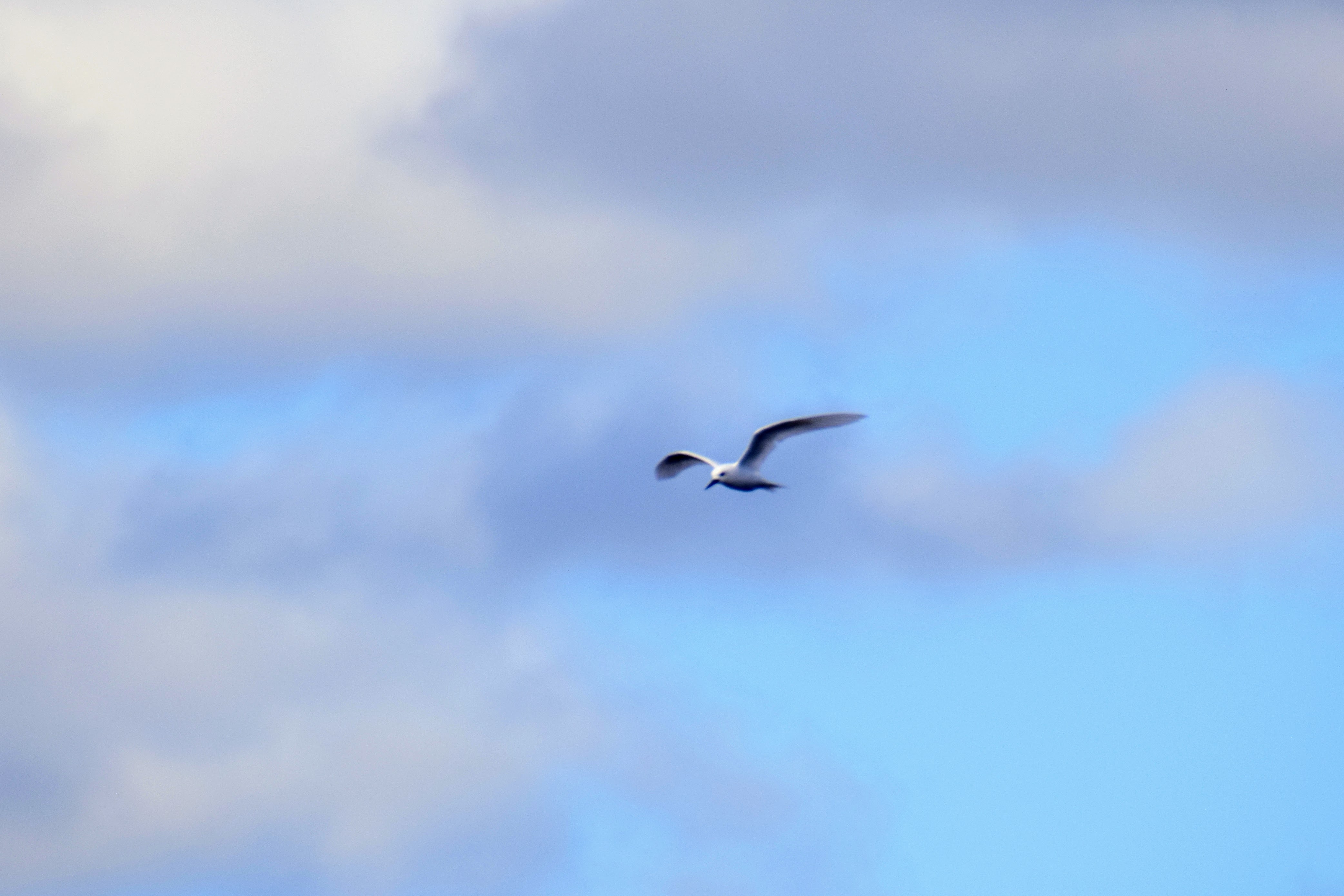
The featherweight and most abundant bird in the flock were the White Terns, also known as “fairy terns” since they’re so small and have hypnotic-looking eyes. These were the only seabirds I also saw in the city, where they were easily confused with white pigeons in flight!

Here’s a Brown Booby (left), White Tern (right), and Great Frigatebird (right) in silhouette.

Here’s a zoomed out view of the bait ball.
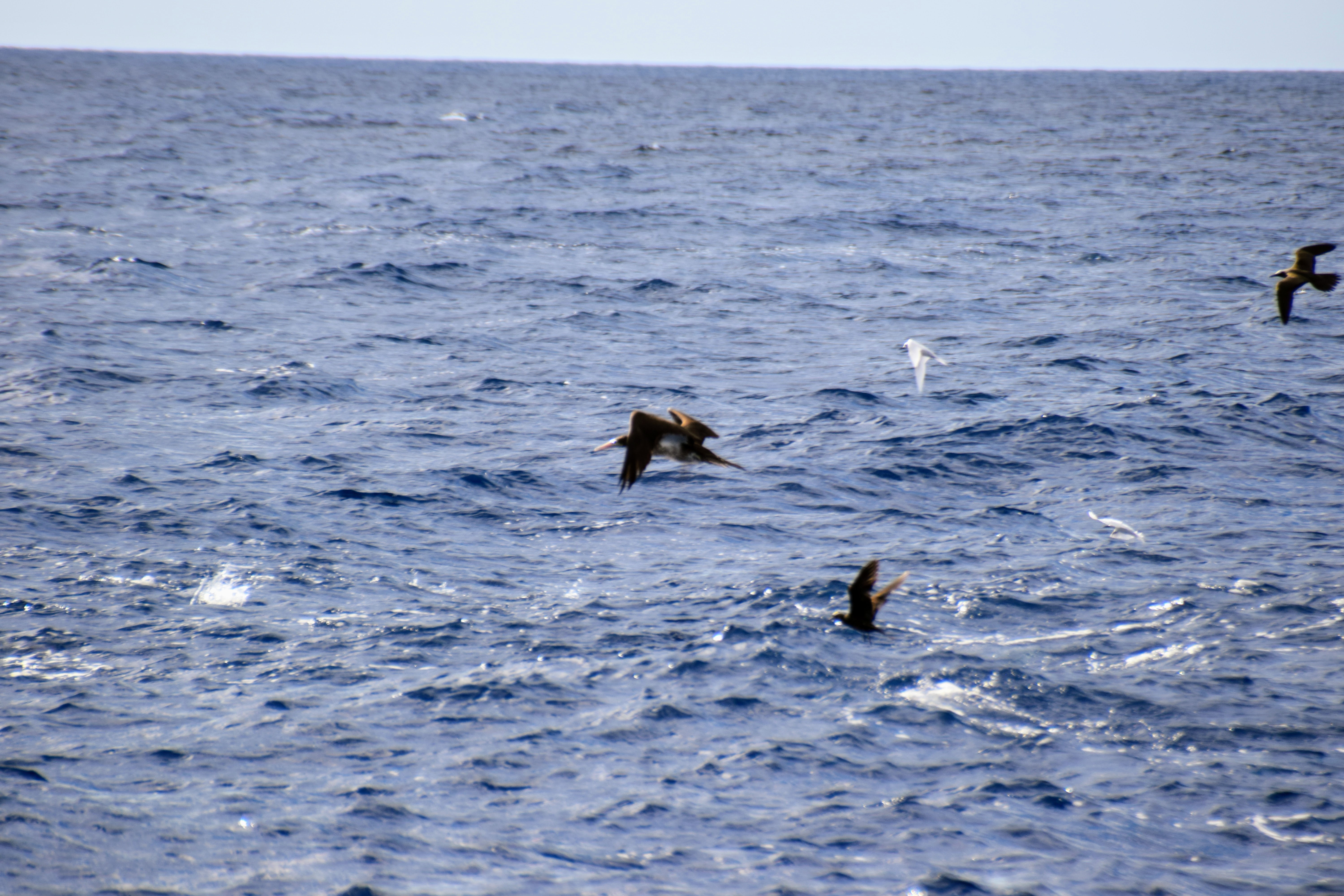
Here’s a Brown Booby, some Brown Noddies, and a White Tern together.
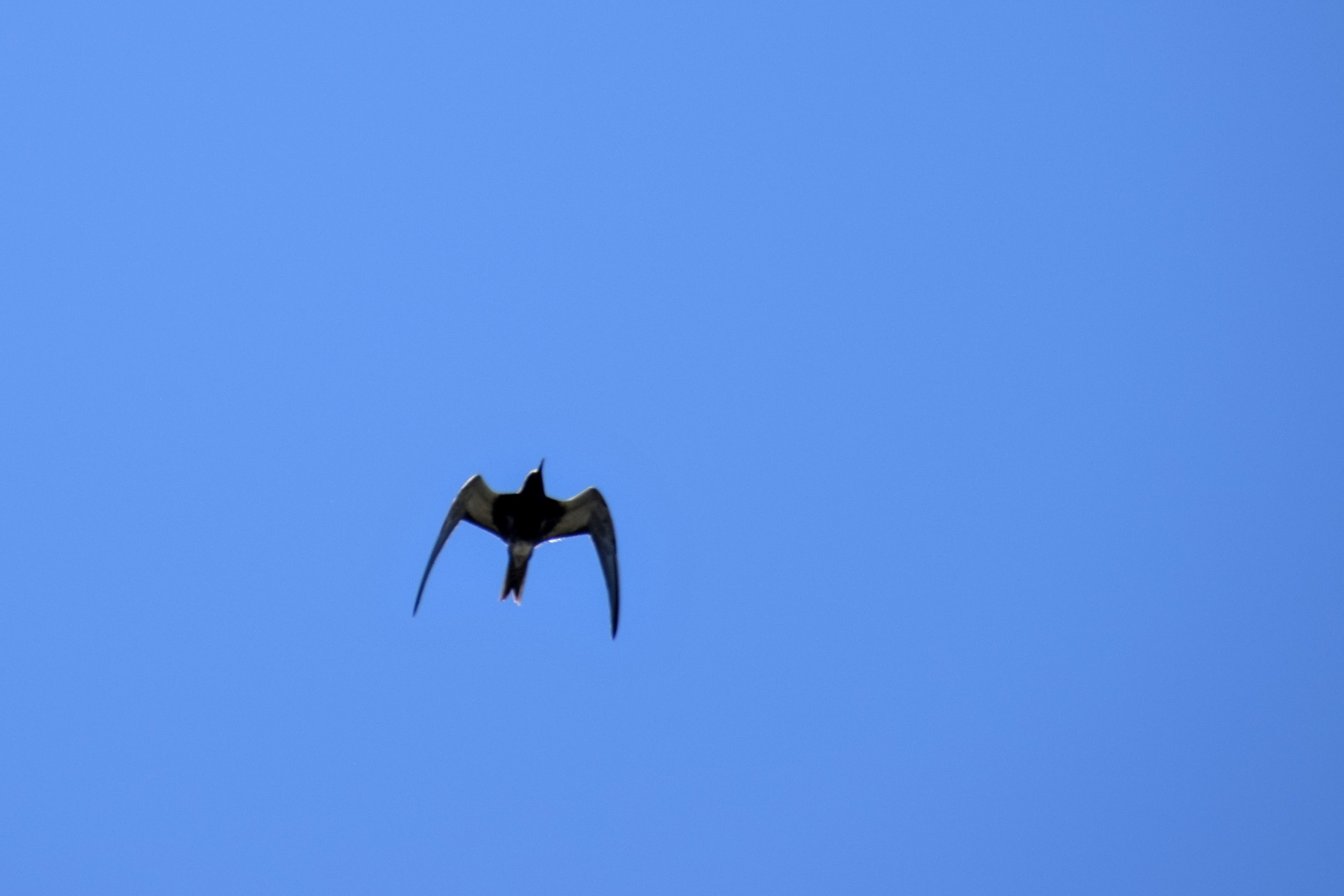
The other type of tern we saw in Hawai’i was the Sooty Tern. It’s not the best name in my opinion, as only juveniles truly look “sooty”, while adults are cleanly black and white.
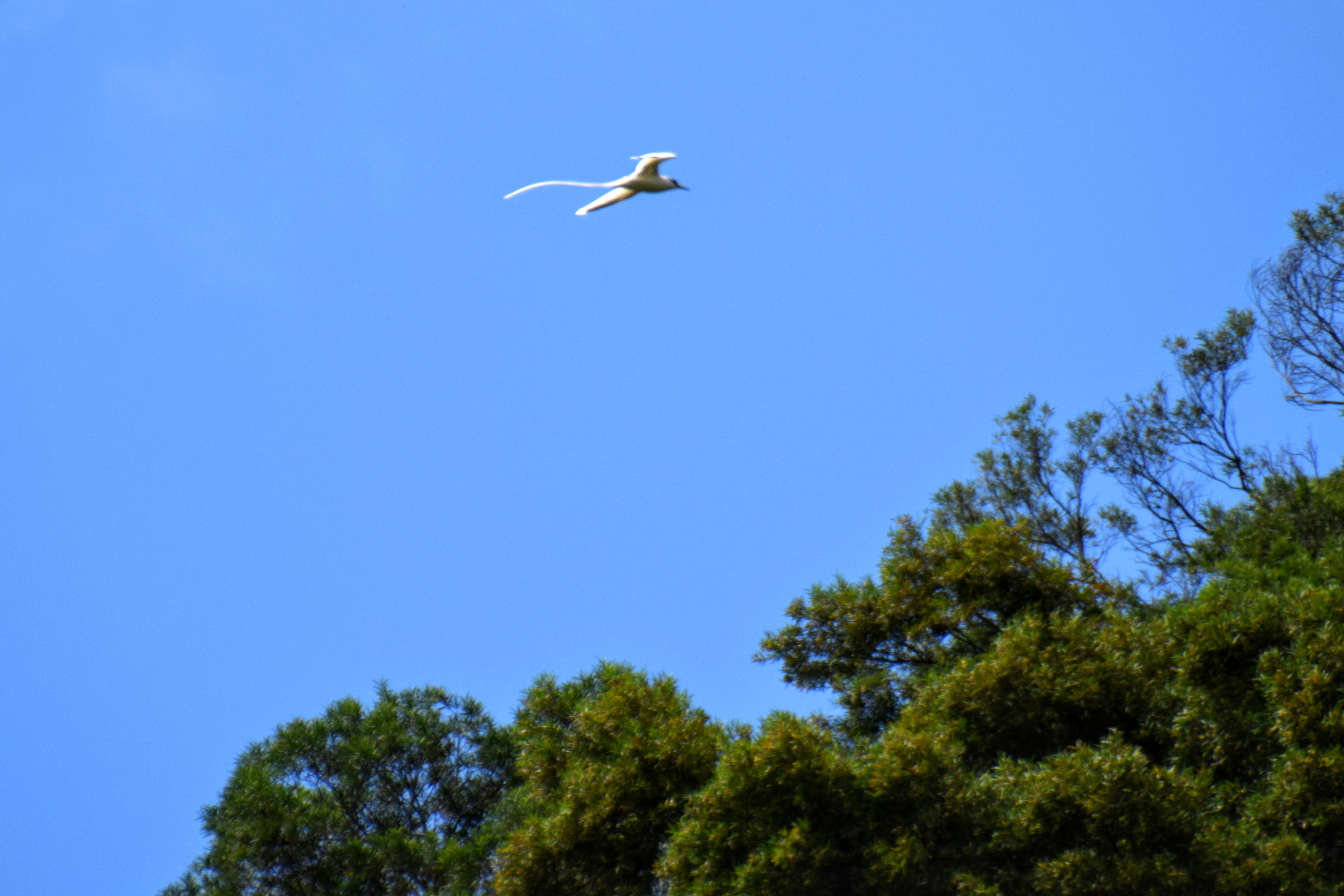
This is a White-Tailed Tropicbird, a bird distantly related to the waterbirds. We spotted this one near the Waimea waterfall.
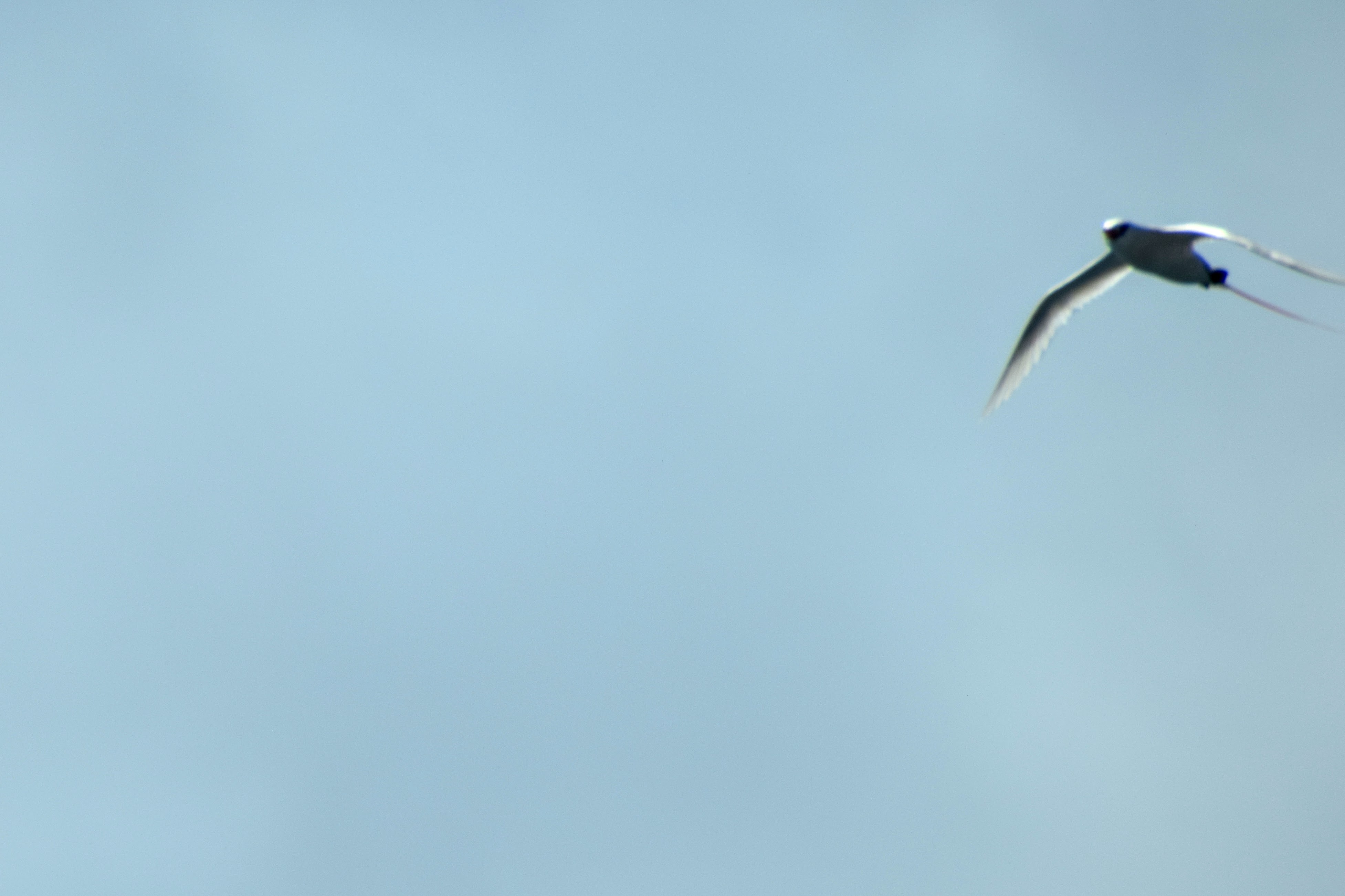
This is a Red-Tailed Tropicbird, a close relative of the White-Tailed but with red tail streamers. I took this photo from a moving car, and all the other photos I got of the this bird were even worse!
Invasive Rainforest Birds
Though O’ahu is only a 45-minute drive from one end to the other, it contains lots of distinct microclimates due to the high volcanic mountains in the middle of the island. The northern half of the island gets the brunt of the wind and rain, and the southern half is near desert in some places. Our resort was in the southwestern corner of the island, the driest part, so we had to make excursions to the windward side to visit the jungle.
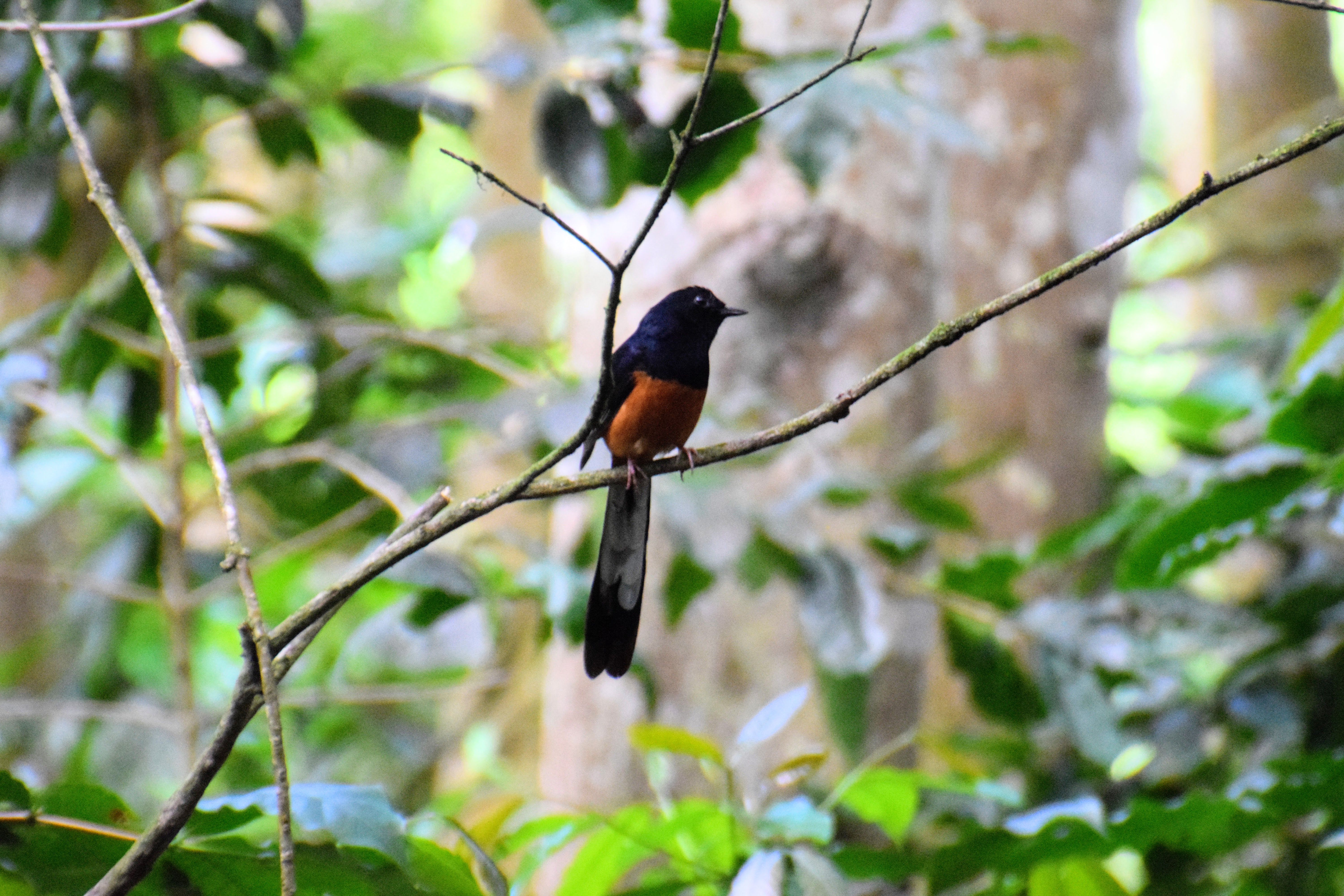
This is a male White-Rumped Shama, a type of Old World flycatcher deliberately introduced to Hawai’i, for some reason, from India and Southeast Asia in the 1930s and 40s. It has a complicated song that it was performing for us while I took this picture.
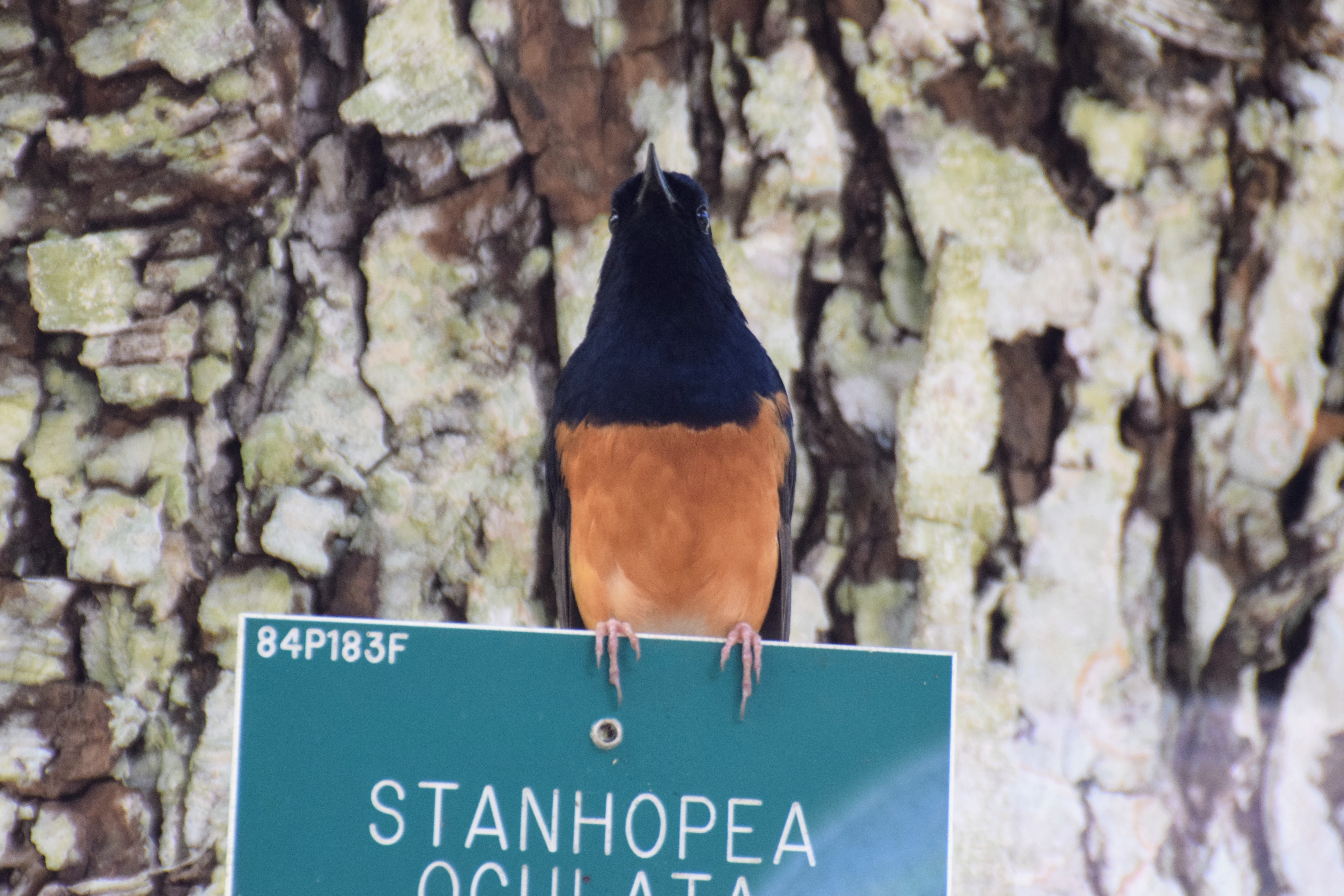
Due to its superficial similarity to American Robins and other thrushes, it used to be classified in that family before DNA decoding rearranged the bird family tree.
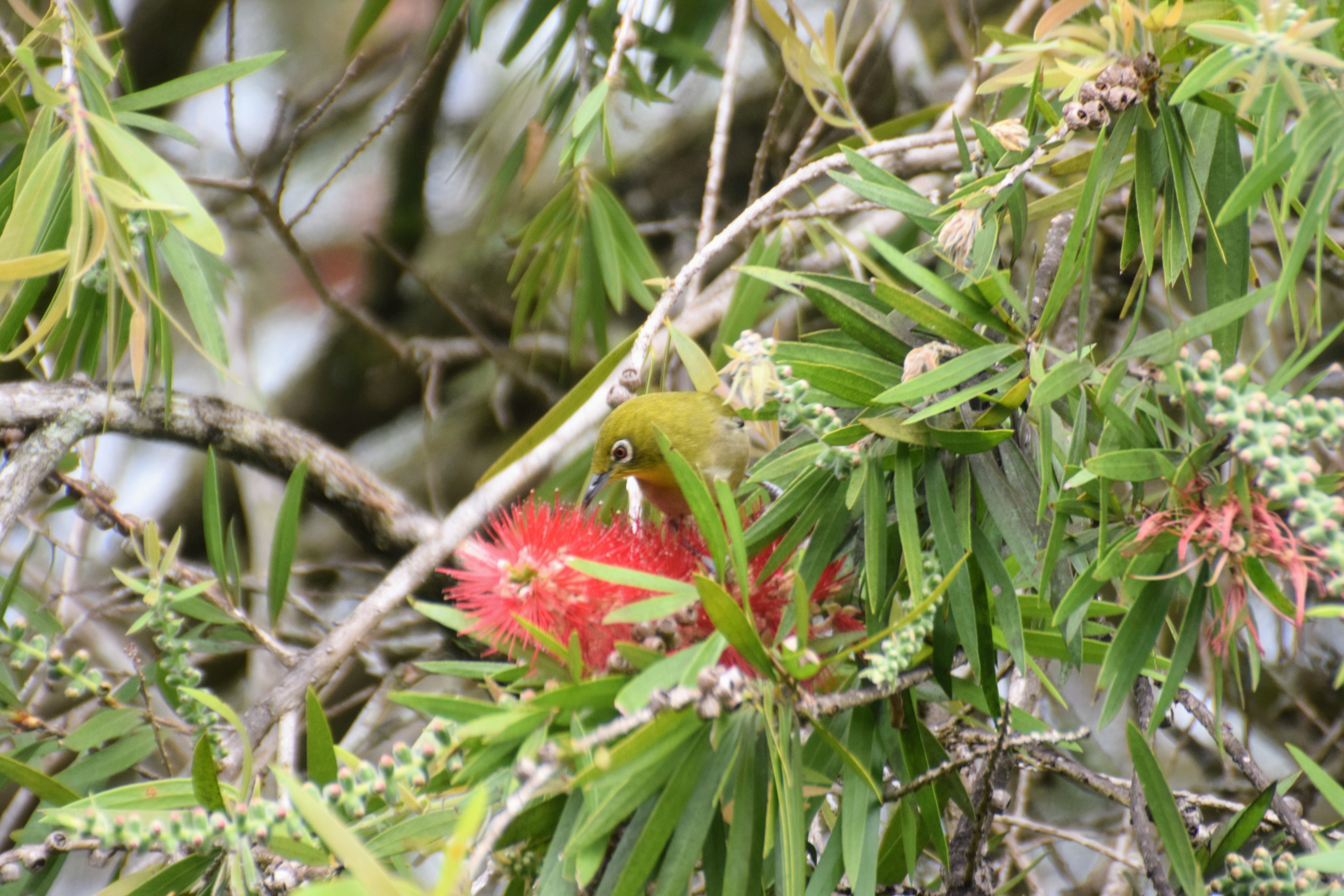
This is a Warbling White-Eye, a bird related to the bulbuls that was also deliberately introduced from Asia in 1929 under the impression that it would help reduce insect pest populations on the island. Instead, it reduced native bird populations, especially the honeycreepers, and the insect population stayed about the same. This White-Eye is gathering nectar from these bottlebrush flowers (which hail from Australia).
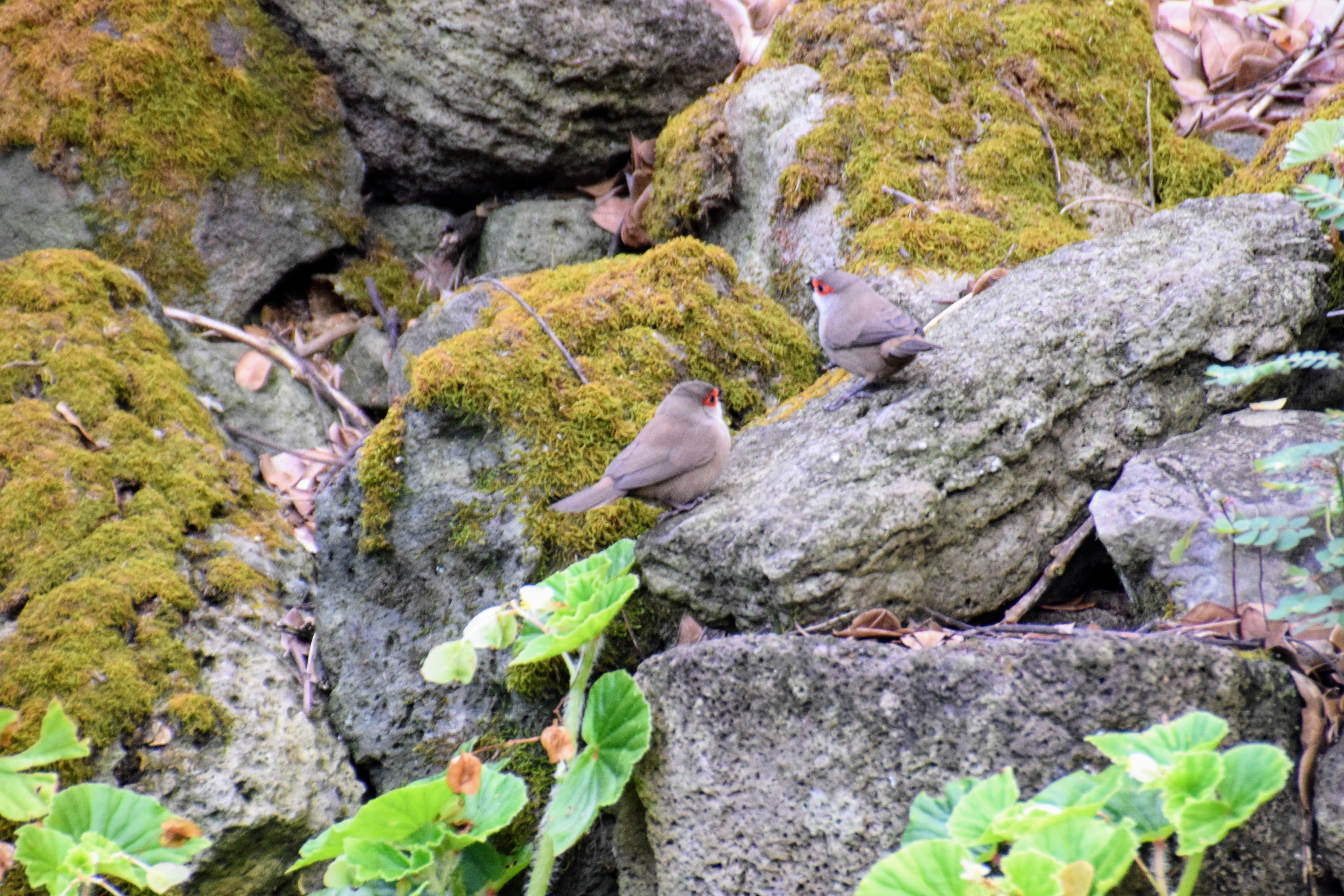
These teeny friend-shaped guys are Common Waxbills, named for their bills’ resemblance to the red wax seals of the 19th century. They are native to the southern half of Africa and were introduced to Hawai’i accidentally as escaped pets. Here, they are socializing on top of a burial cairn along the Waimea waterfall trail. Is that disrespectful?
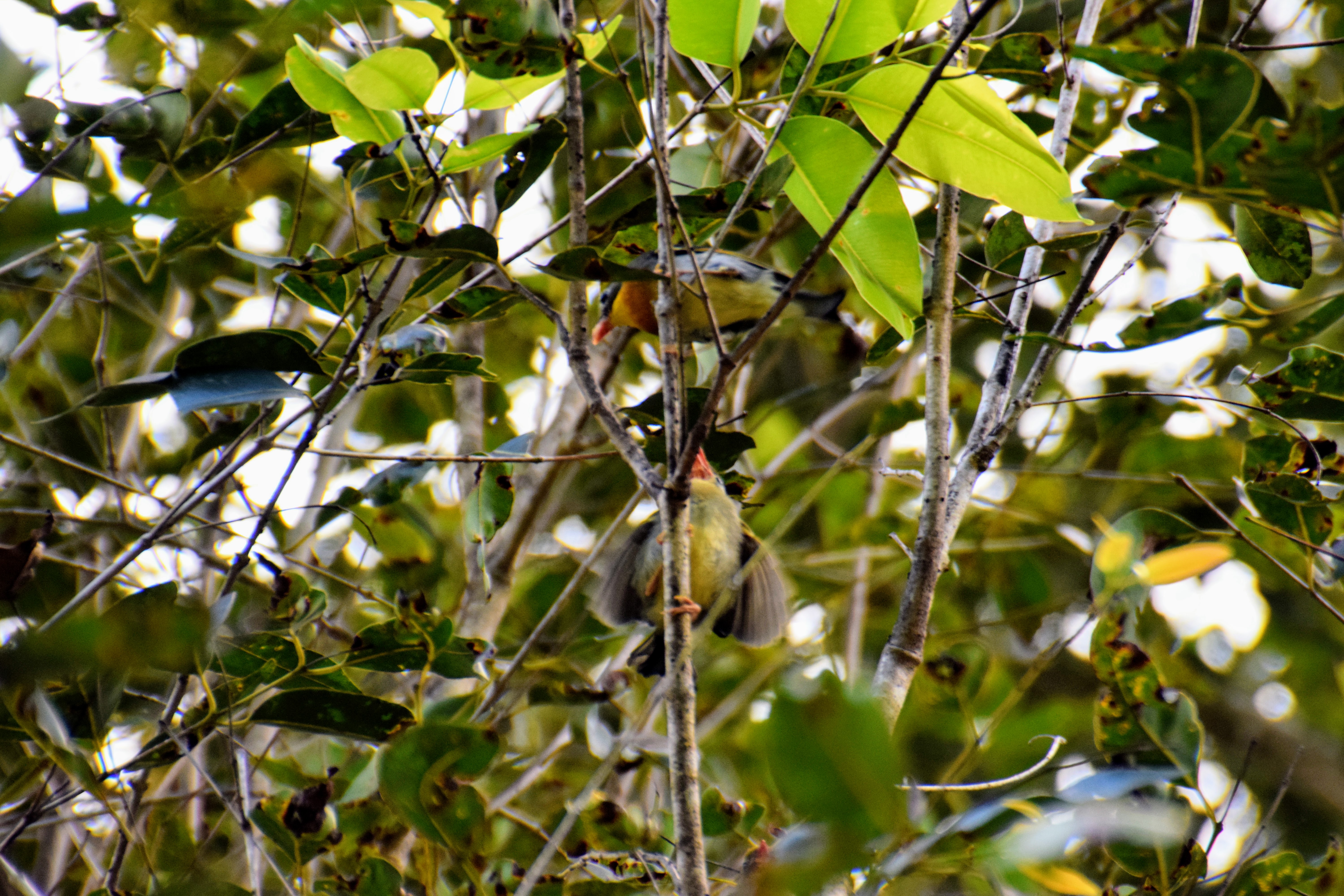
These are Red-Billed Leiothrixes (Leiothrices?), another deliberately introduced South Asian jungle bird. It’s not very common on O’ahu anymore, and these two individuals were the only ones I saw. The bottom one is a baby, floofing its wings to beg food from its parent (top). I always think fledglings look way too big to still be begging.
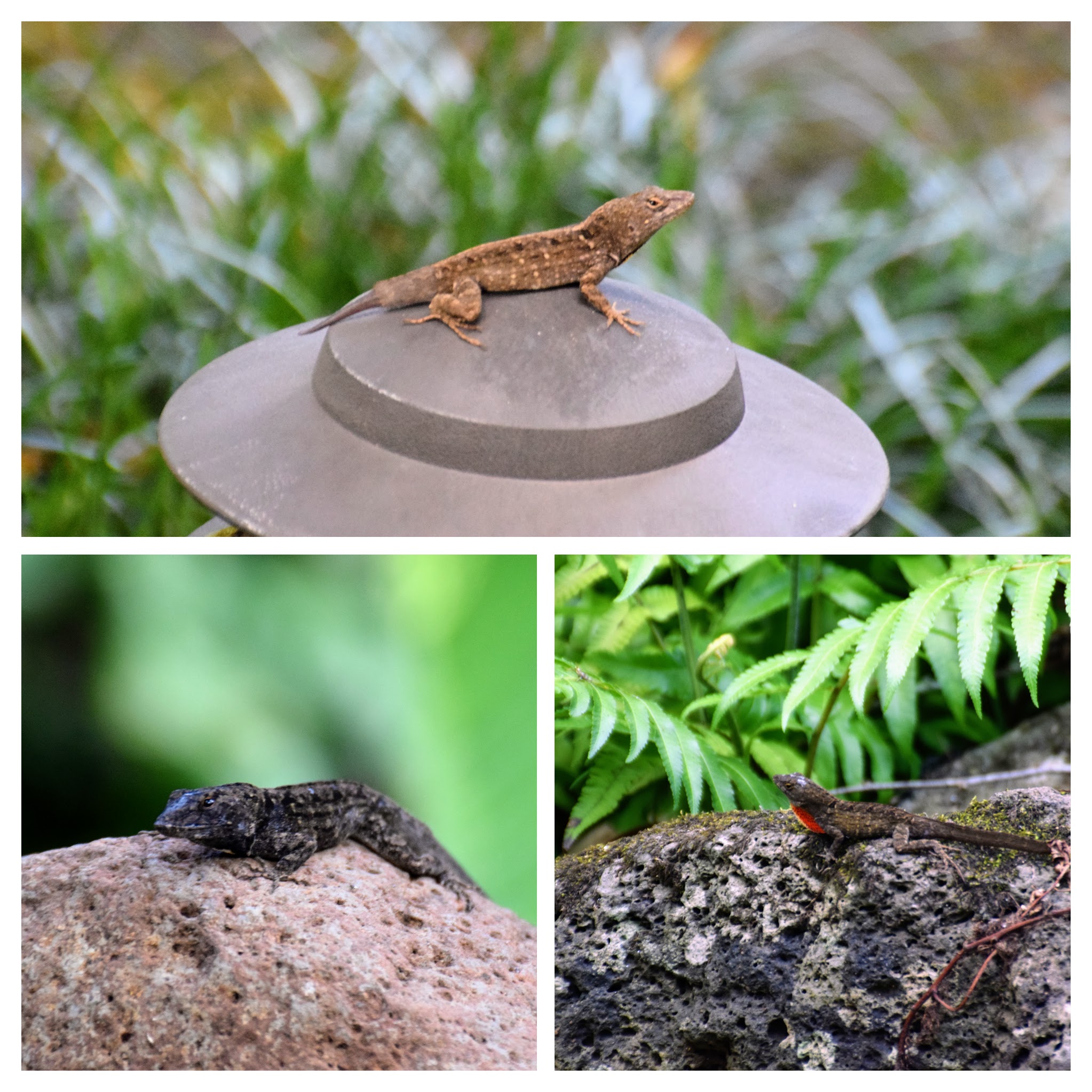
These are brown anoles, a type of lizard native to the Bahamas and Cuba that was introduced to many places, including Hawai’i, through crops contaminated with lizard eggs. They can change color from brown to black. The one with his dewlap slightly out was trying to impress a female on a rock below. I waited for a long time for him to stick his dewlap fully out, but both male and female just sat there for minutes. Darn cold-bloods!
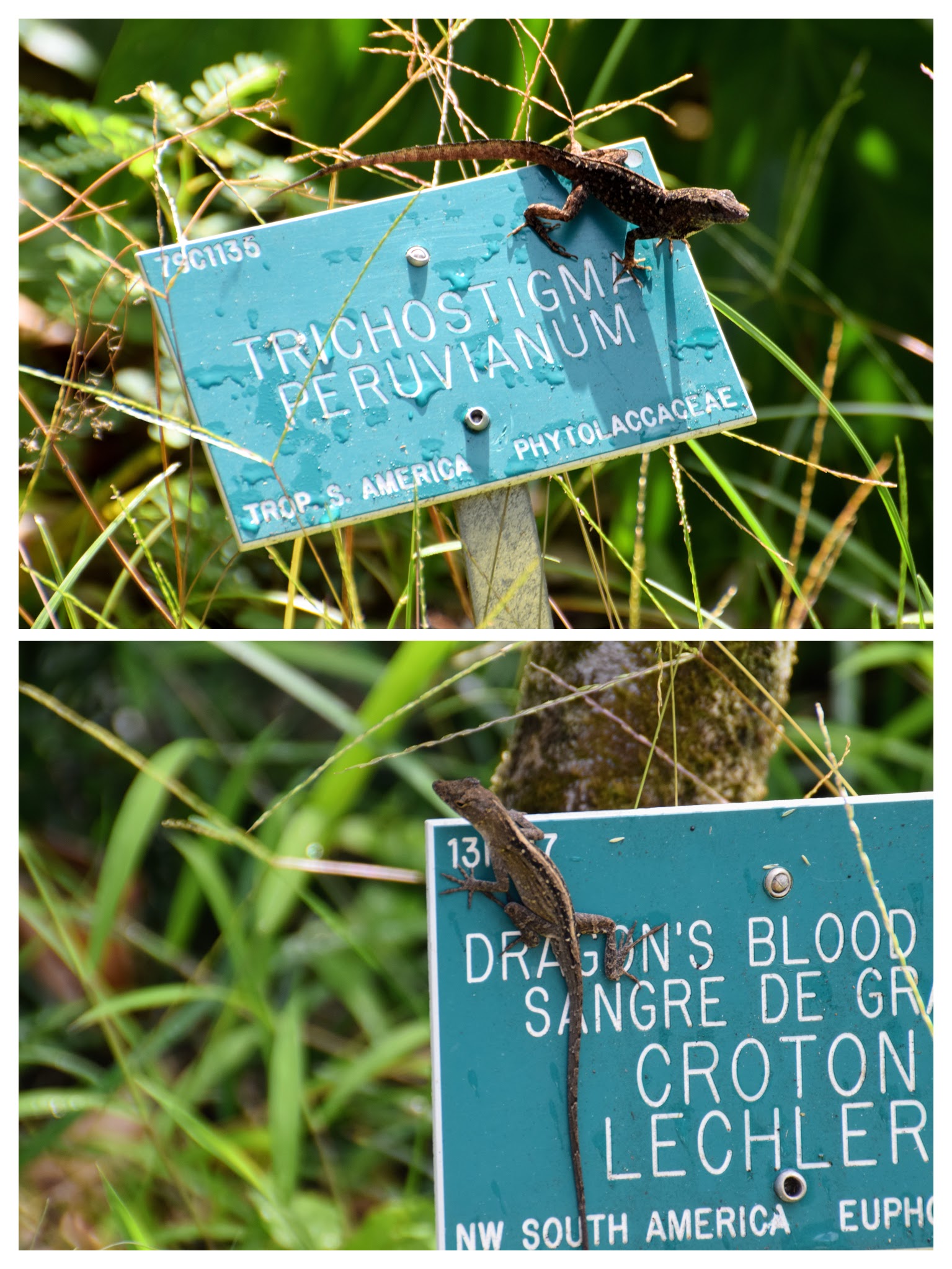
Lizards love sunning themselves atop botany signs. This isn’t the first time I’ve taken pictures of them doing this. The signs are probably warm!
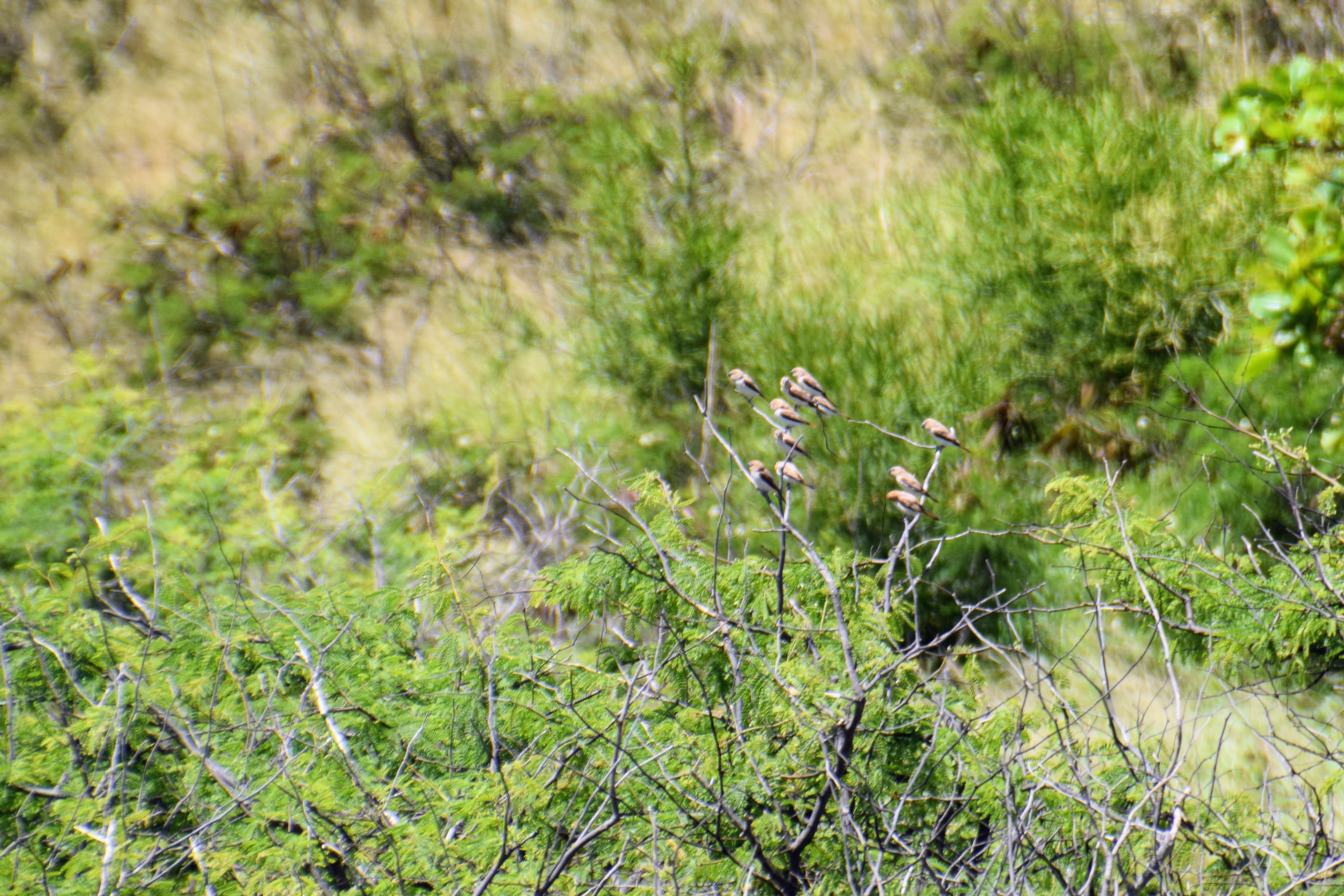
These next two aren’t rainforest birds, but I didn’t want to make an entire section just for them. These are African Silverbills, a relative of the Common Waxbill that we encountered on a clifftop near Makapu’u Lighthouse. They are native to the dry savannas just south of the Sahara Desert, and were also introduced accidentally in the ’60s and ’70s as escaped pets.
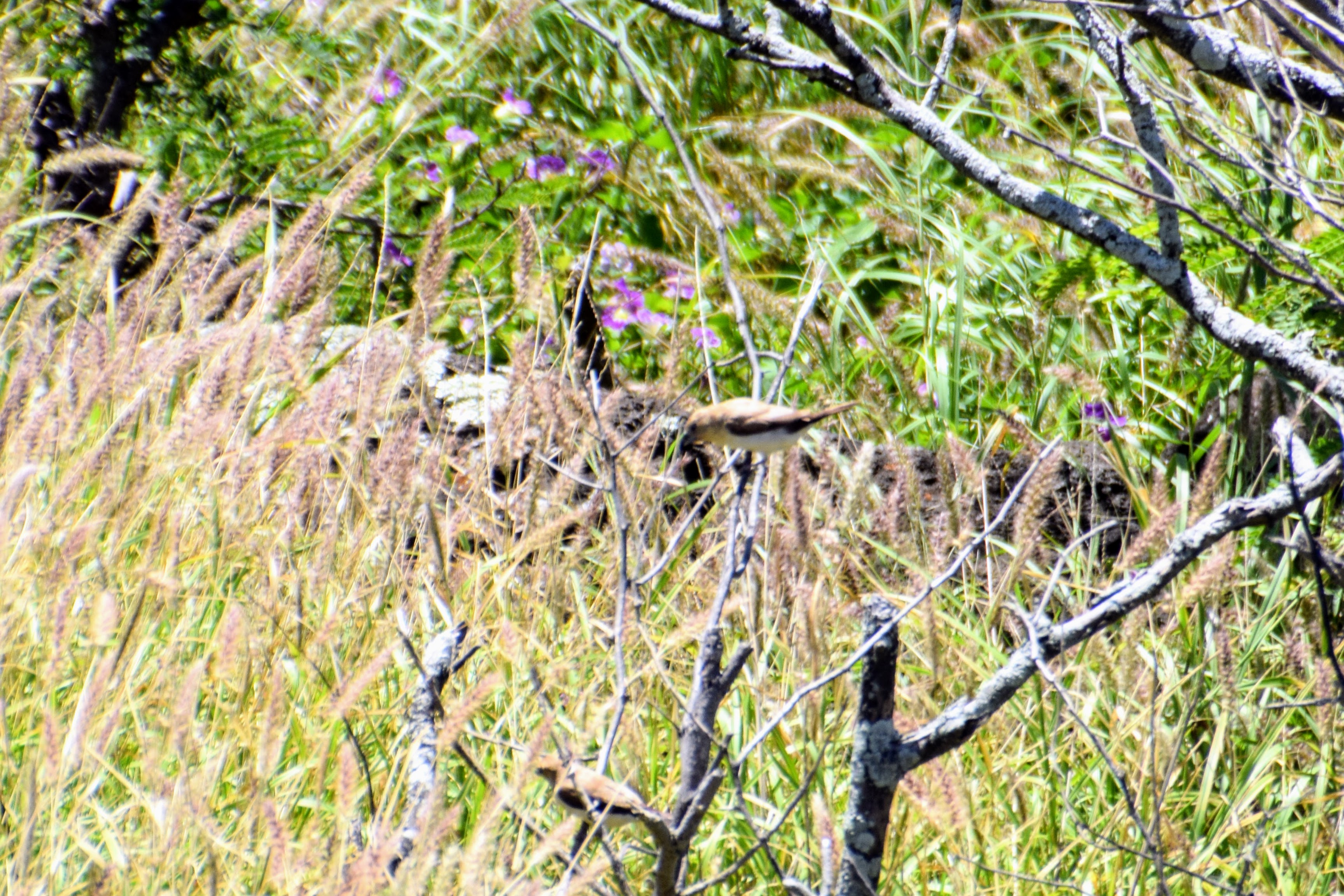
Wikipedia says silverbills are “a particularly inactive bird, sitting huddled together for long periods of time”. But this was the closest picture I was able to get! Should I be offended?
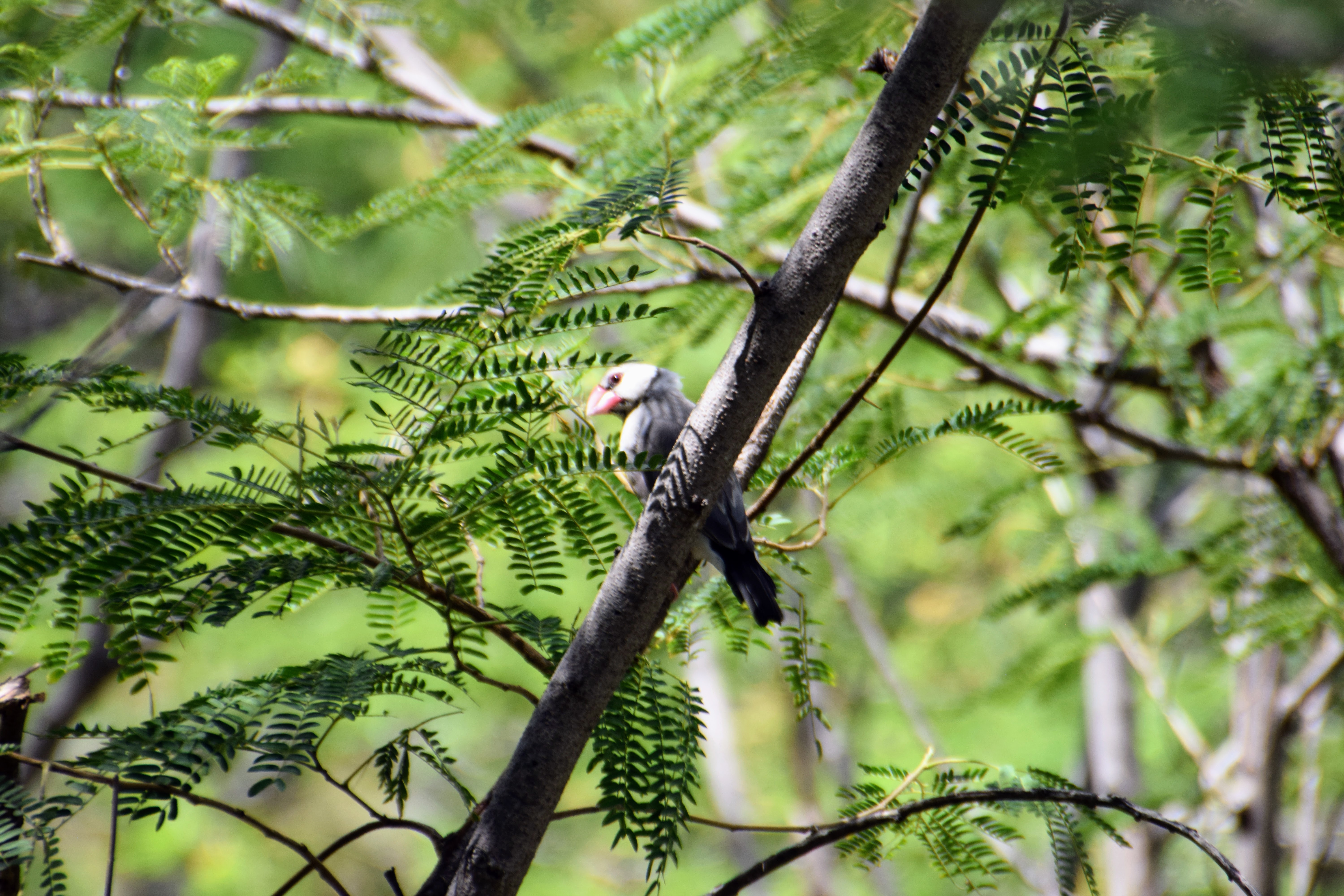
This is a Java Sparrow, a larger relative of the waxbills that is native to Indonesia and introduced as escaped pets.
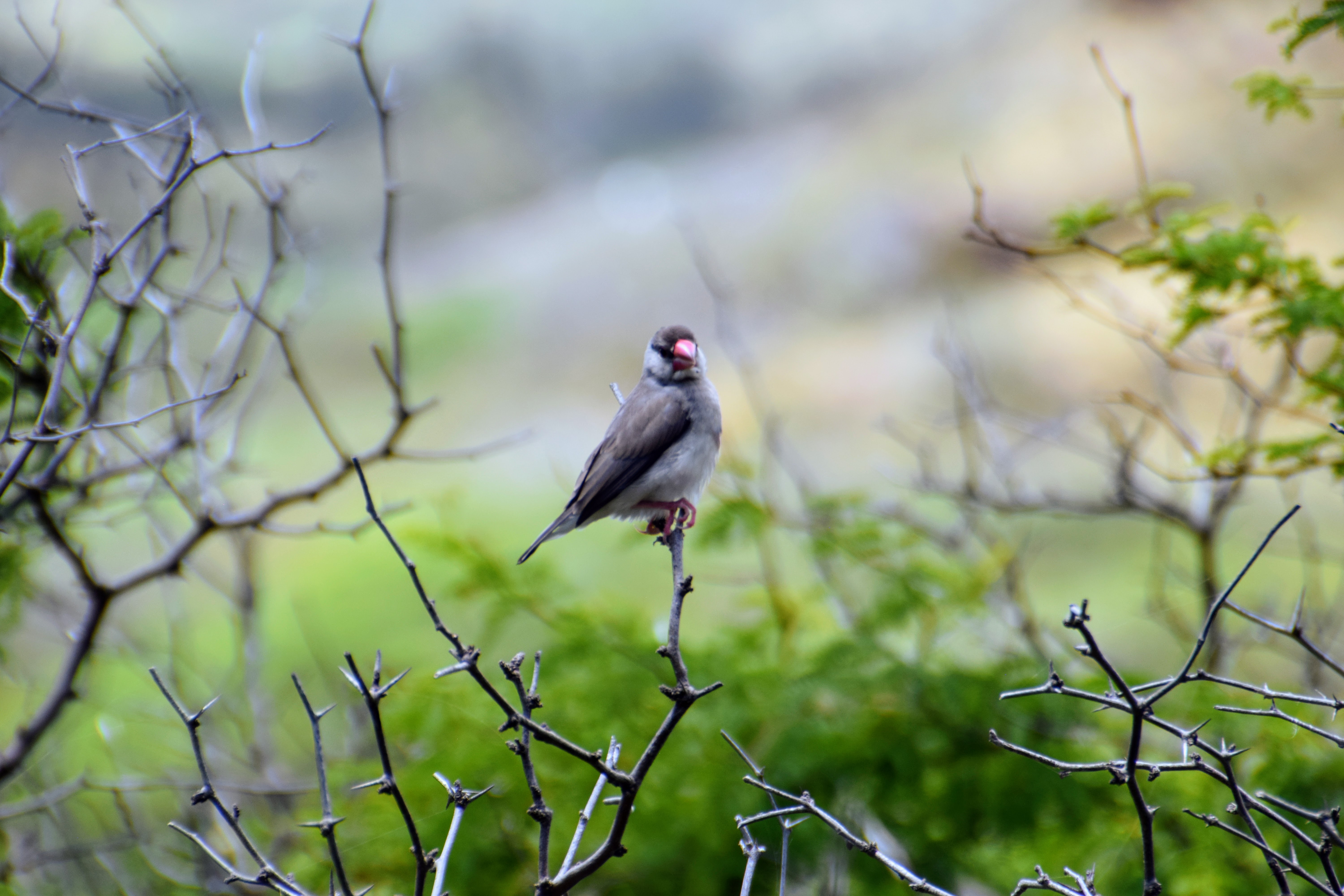
Unlike most of the other invasive birds we’ve seen so far, this one is endangered, as it was persecuted as an agricultural pest for eating unripe rice. There’s estimated to be fewer than 10,000 individuals left in the world…and this is one of them!
Golf Course Birds
There was a golf course right across from our resort, which sported a couple of water features and lots of lawn space. Certain birds are attracted to those things, so I walked through and spotted a few new birds.
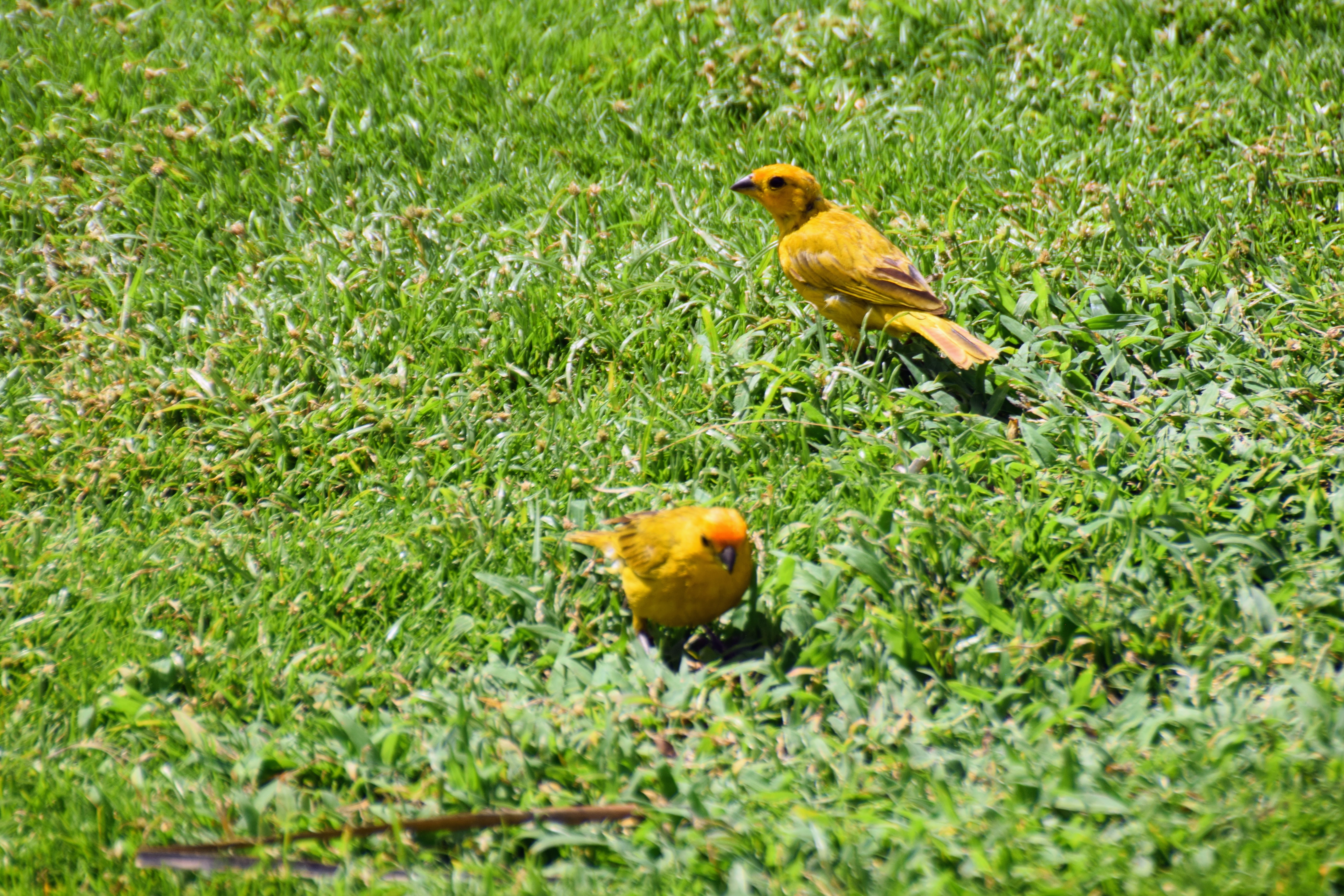
These are Saffron Finches, which aren’t true finches despite the resemblance. Atlantic Canaries, which look extremely similar to Saffron Finches, are also true finches and evolved this look independently.
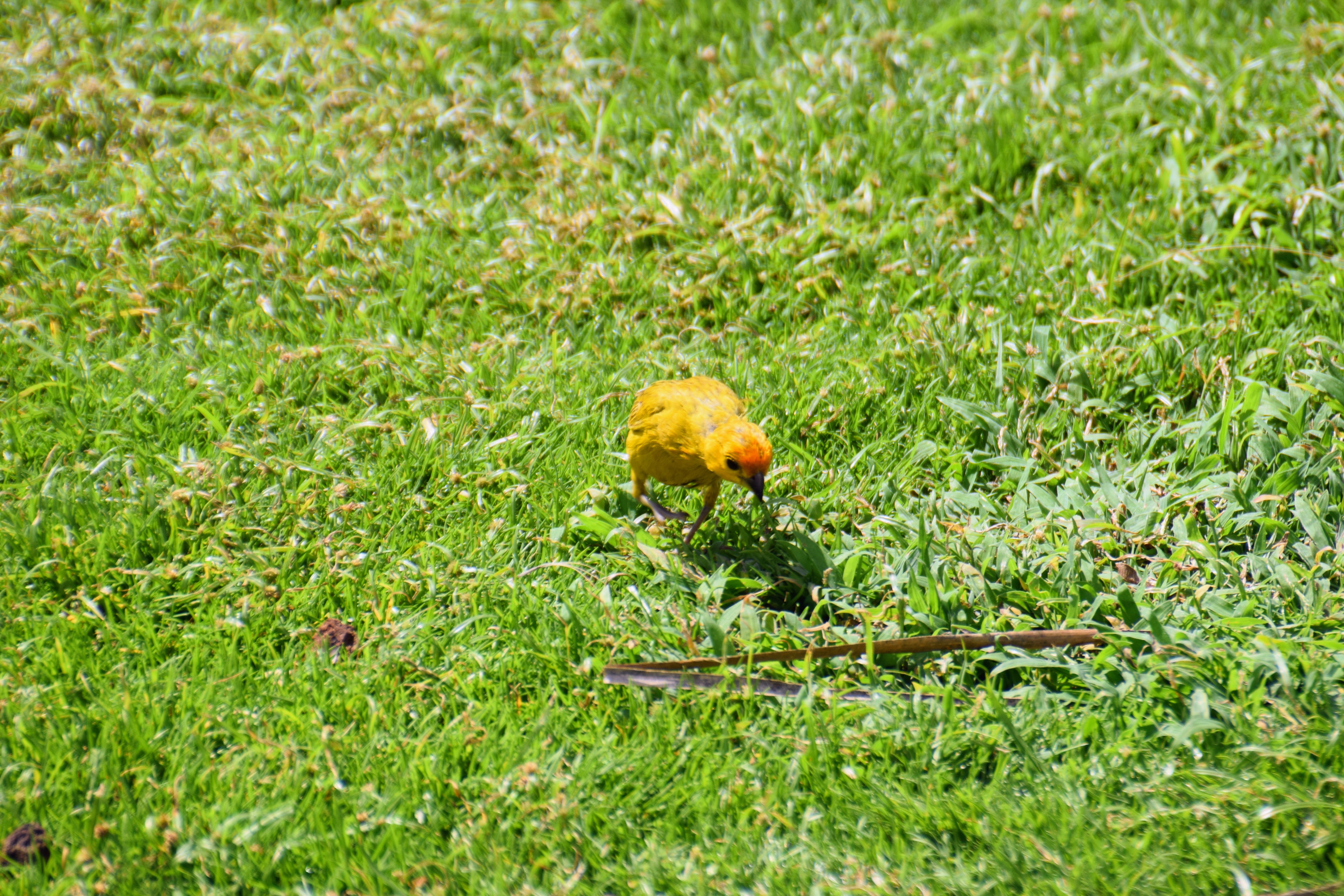
This one looks like a sphere with stick legs.
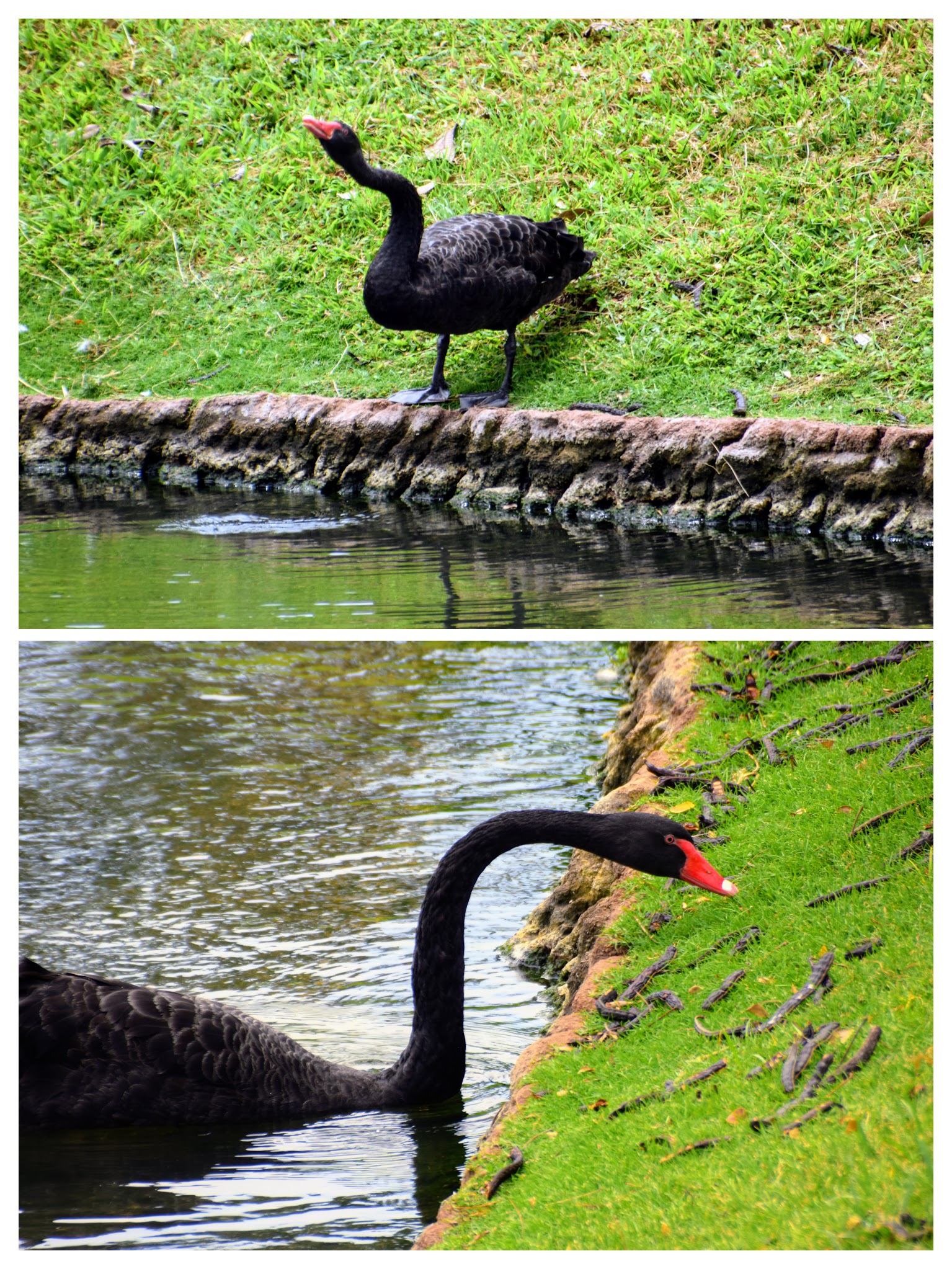
These Black Swans were probably imported to make the golf course look fancier. Look at that neck! Swans and geese are the only birds for whom grass is an important part of their diet.
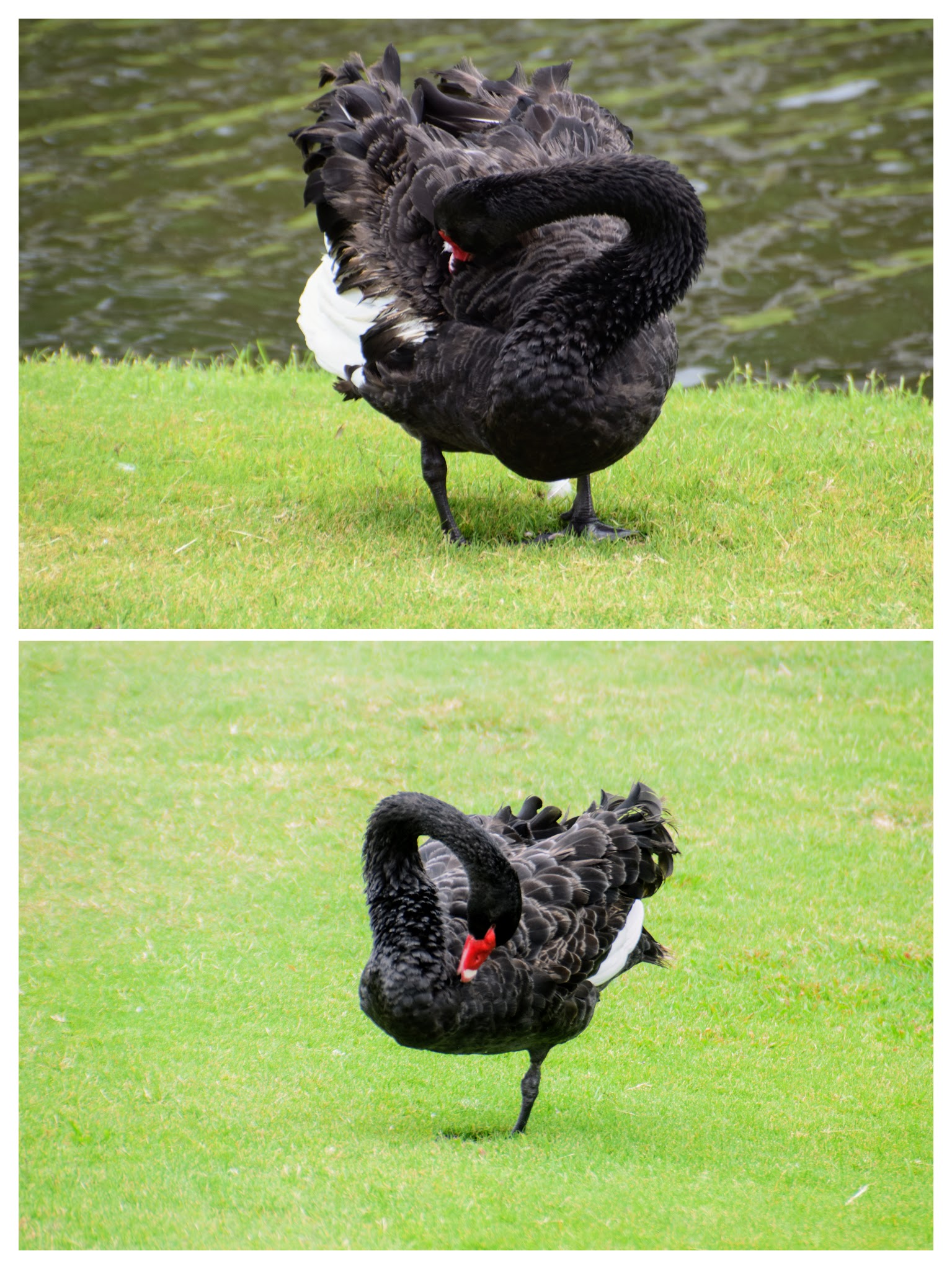
These swans were busy preening. I wanted to get a photo of one with its wings out, but I waited a long time to no avail. How is that one balancing on one leg? It looks so asymmetrical!

This is a male Koloa (Hawai’ian duck) / Mallard hybrid. Koloa males look the same as the females with no green head, and this one just has green along the back of his neck. You can also tell it’s a male by the one curly tail feather. Hybridization between Koloa and Mallards is common, though the Koloa itself is endangered.
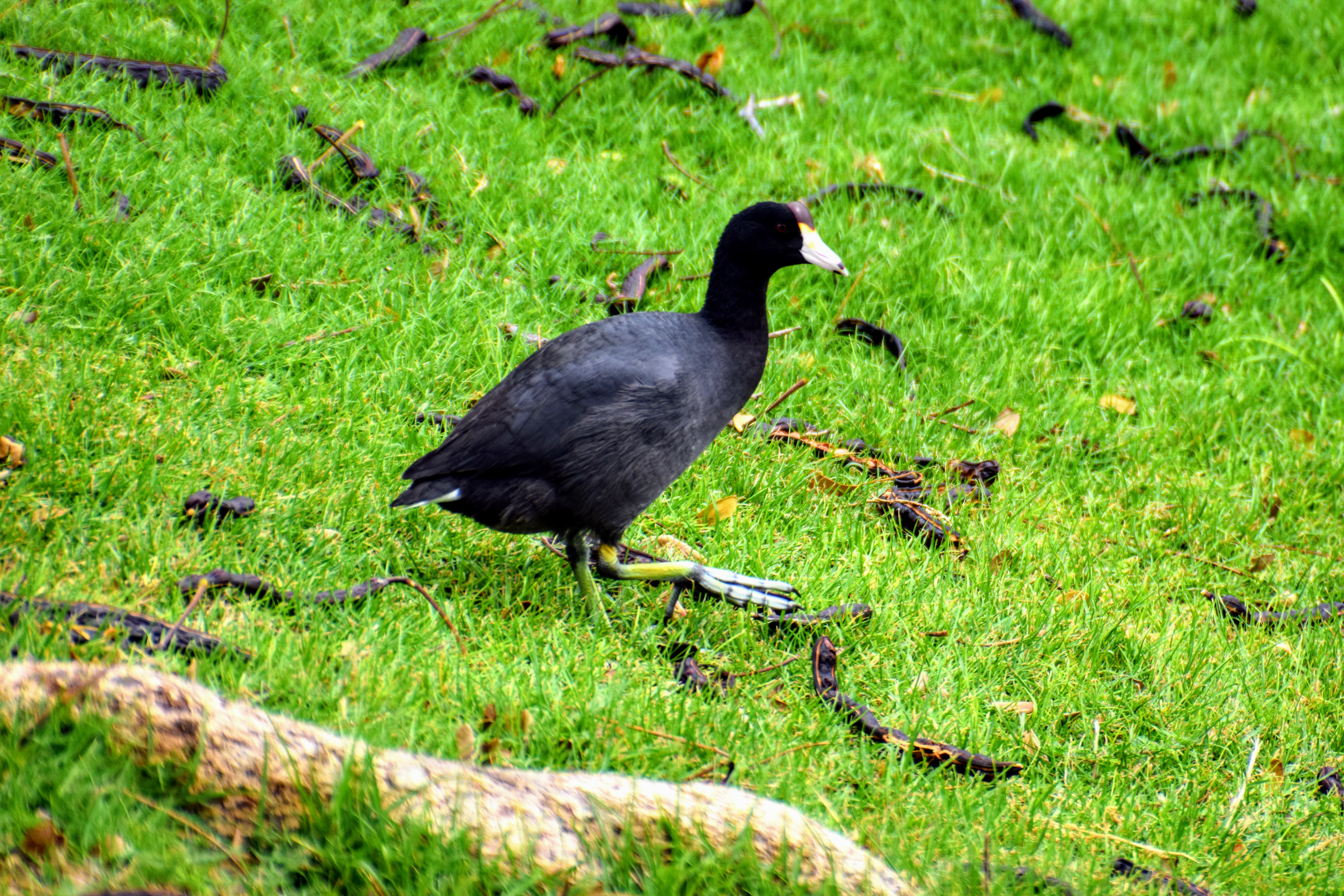
This is a Hawai’ian Coot, a bird closely related to the American Coot but distinguished by its bulbous head shield. Similarly to American Coots, instead of webbed feet they have oar-shaped toes.
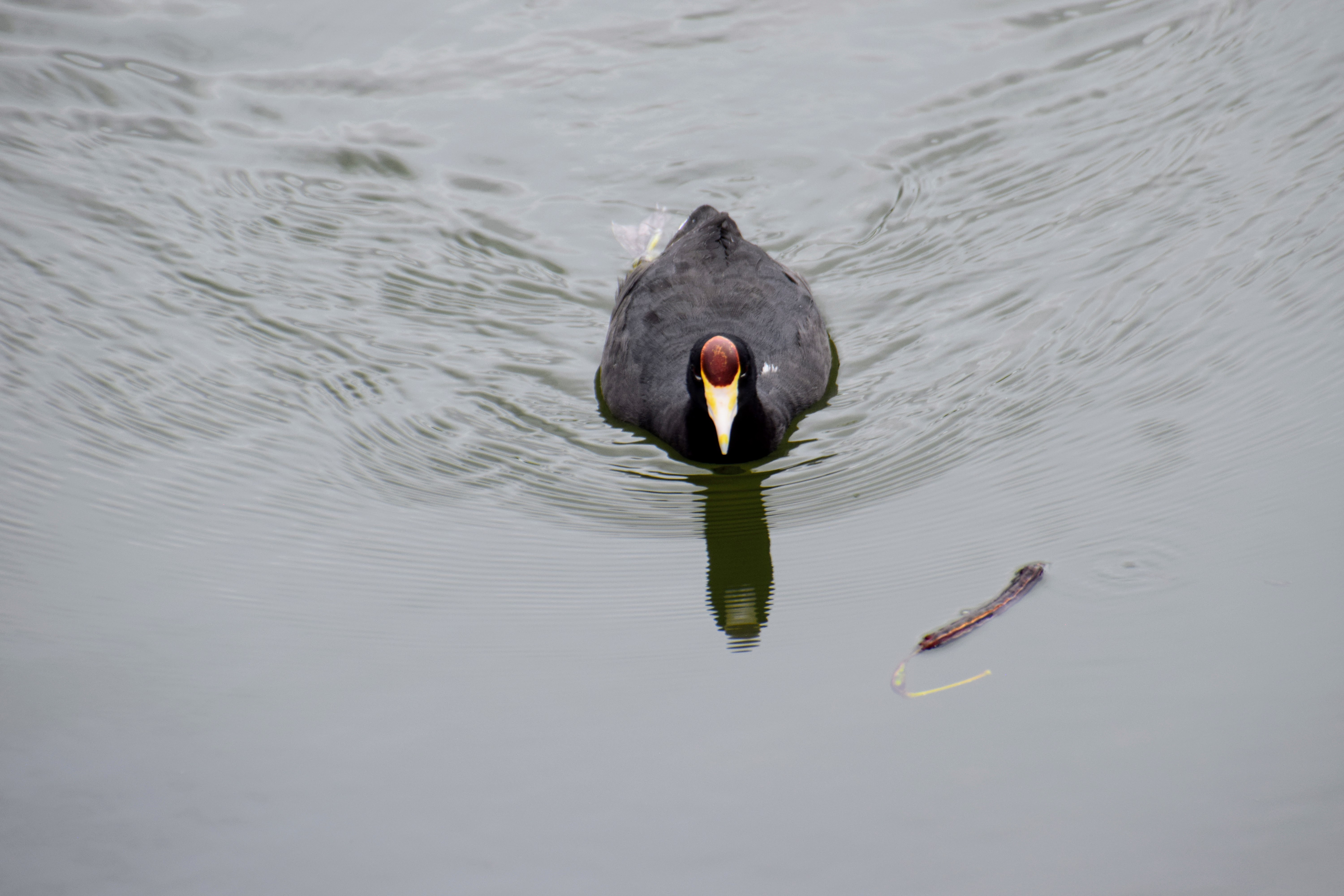
Wow, such symmetry.
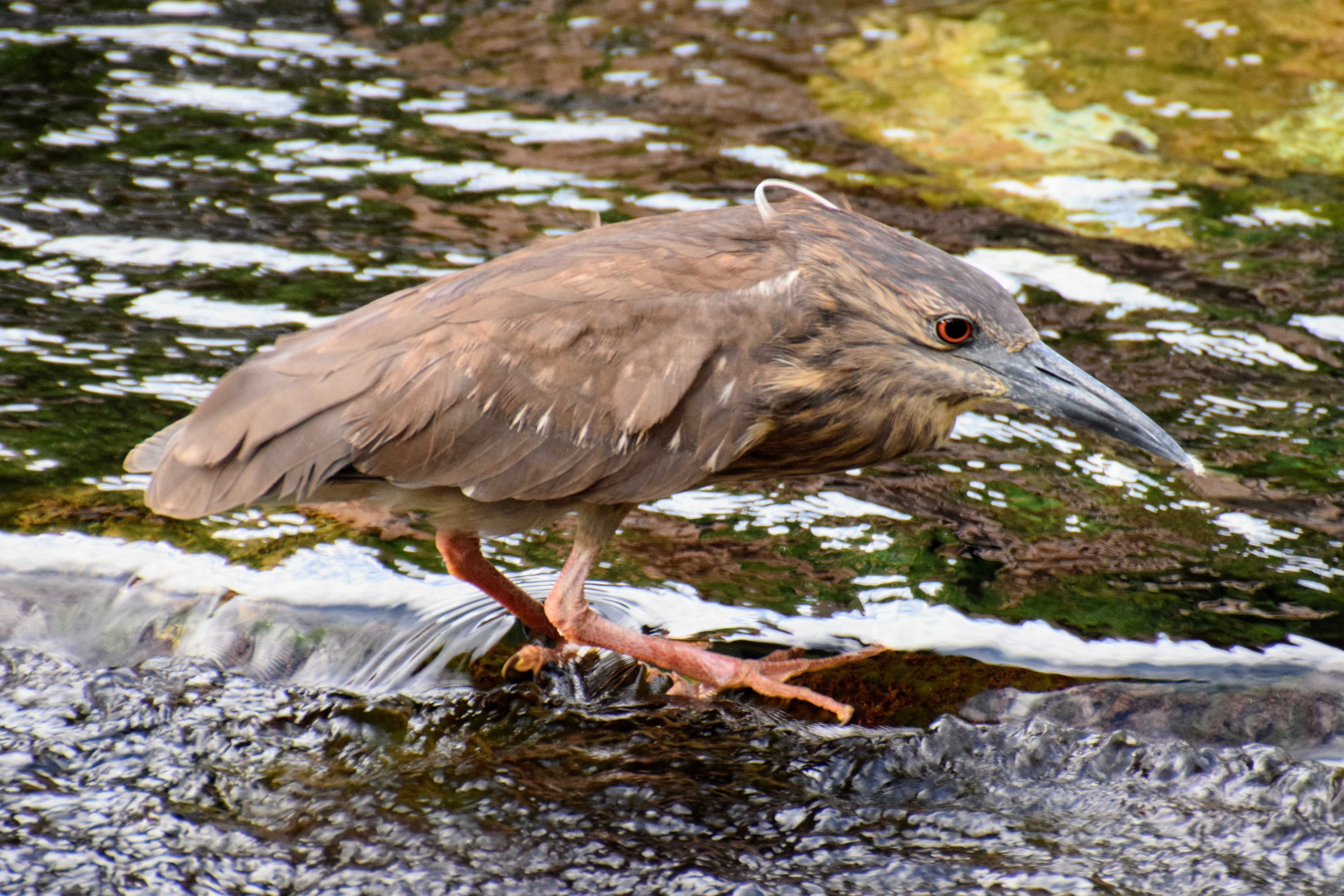
This is a juvenile Black-Crowned Night Heron, a bird I’ve taken photos of in California and Florida before. This one was standing like a statue in a water feature in the resort next door to ours, while the wind blew his feathers around. What is he pondering?

This is a mongoose. They were introduced to reduce rat populations (which were introduced by accident as stowaways aboard ships); however, as rats are nocturnal and mongooses are diurnal, the latter mostly ate Hawai’ian birds and turtle eggs instead. Mongooses are native to the Old World, so this is the only place in the United States where there is a wild population. This one froze when he saw me point my camera at him, allowing me to take pictures while he believed I didn’t see him. Then when I looked away for a second, he dashed off into the bushes.
